-
 Artist: Utagawa Toyokuni I (1769–1825) Title: Actors Bando Mitsugorō, Ichikawa Danjūrō, Onoe Kikugorō in play The Maiden at Dōjō Temple. Presumably Bunka 13 (1816) at Nakamura Theater in Edo. Publisher: Mikawaya Seiemon (c. 1805-1829); Marks' "Publishers" № 328, p. 235. Size: Vertical ôban MEDIUM OR TECHNIQUE: Woodblock print (nishiki-e); ink and color on paper. Signed: Toyokuni ga Censor's seal: kiwame Detailed discussion on the topic can be seen at: The Maiden at Dōjō Temple
Artist: Utagawa Toyokuni I (1769–1825) Title: Actors Bando Mitsugorō, Ichikawa Danjūrō, Onoe Kikugorō in play The Maiden at Dōjō Temple. Presumably Bunka 13 (1816) at Nakamura Theater in Edo. Publisher: Mikawaya Seiemon (c. 1805-1829); Marks' "Publishers" № 328, p. 235. Size: Vertical ôban MEDIUM OR TECHNIQUE: Woodblock print (nishiki-e); ink and color on paper. Signed: Toyokuni ga Censor's seal: kiwame Detailed discussion on the topic can be seen at: The Maiden at Dōjō Temple -
 An iron tsuba in the shape of a bold or shaved human head in full round. Unsigned. Dimensions: 62.5 x 53.4 x 4.4 mm Iron, in the shape of a Ni O (Nio) head, in full round, the back flat chased as a pine forest. Signed : Miōchin Masatsugu in sosho. №38 in The Naunton Collection, 1912. There are a few tsuba of such design known. SOLDIron, a severed head. Signed: Takeaki of Kwaiyō. Ex Hawkshaw Collection [Plate VII]. Below written: Takurio, Suruga, 1118; Tamagawa, p. ; Tanaka, p. 168; Tanetora, 1894. №2729 in The Naunton Collection, 1912.
An iron tsuba in the shape of a bold or shaved human head in full round. Unsigned. Dimensions: 62.5 x 53.4 x 4.4 mm Iron, in the shape of a Ni O (Nio) head, in full round, the back flat chased as a pine forest. Signed : Miōchin Masatsugu in sosho. №38 in The Naunton Collection, 1912. There are a few tsuba of such design known. SOLDIron, a severed head. Signed: Takeaki of Kwaiyō. Ex Hawkshaw Collection [Plate VII]. Below written: Takurio, Suruga, 1118; Tamagawa, p. ; Tanaka, p. 168; Tanetora, 1894. №2729 in The Naunton Collection, 1912.
№38 Naunton Collection, 1912.
Reference to Hawkshaw Collection [Plate VII] happened to be not exact; it is Plate VIII, №236. It is clearly not the Hawkshaw piece (different facial expression, signle hitsu-ana, no plug. Description at Hawkshaw, 1910, reads: Iron, in the shape of a man's head, severed at the neck, the forehead in three wrinkles, the mouth hard-set and drooping, the eyes open, inlaid brass with shakudo pupils. Signed: Shoami; dated second year of Shoho, first month [SV: December 1644 through February 1648].
№2729 Naunton Collection, 1912.

№236 Hawkshaw Collection, 1910.
-
 Iron tsuba of round form with three stylized folding fans motif in openwork (sukashi). Kogai-hitsu-ana with shakudō sekigane. Iron bones (tekkotsu) on the rim. Momoyama period or earlier. Possibly, Ko-Shōami school.
Iron tsuba of round form with three stylized folding fans motif in openwork (sukashi). Kogai-hitsu-ana with shakudō sekigane. Iron bones (tekkotsu) on the rim. Momoyama period or earlier. Possibly, Ko-Shōami school.Size: 76.8 x 75.7 x 4.0 mm.
[Seller alleged that the motif is "Buddhist wheel", which seems unlikely. -
 Kikukawa Eizan (菊川 英山, 1787 – July 17, 1867) Signed: Eizan hitsu (英山筆)
Kikukawa Eizan (菊川 英山, 1787 – July 17, 1867) Signed: Eizan hitsu (英山筆)Jacob Pins #972/p.341. Leiden, Rijksmuseum voor Volkenkunde.
"The Lovers Miura-ya Komurasaki and Shirai Gonpachi: Tragic love stories taken from real life and dramatized were a staple of stage and print; the darkly romantic combination of desire and death was hugely popular in the eighteenth century. Hirai Gompachi was a warrior of the Tottori fief in western Japan who fled to Edo after committing a murder. He was apprehended and sentenced to death in 1679. His distraught lover, the courtesan Komurasaki, committed suicide at his grave." [MET]
.
-
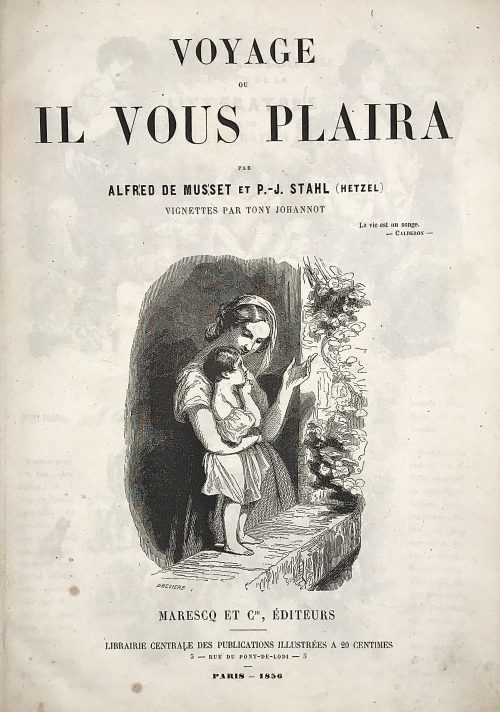
Voyage ou Il vous plaira by Alfred de Musset and P.-J. Stahl (Hetzel); Tony Johannot (illustrations). [Les chefs d'oeuvres de la litterature et de l'illustration] // Marescq et Cie, éditeurs, - Paris, 1856.
Contes de Charles Nodier by Jean Charles Emmanuel Nodier (1780 – 1844) illustrated by H. Émy.
Owner's binding in red half Morocco, A4 (297 x 219 mm). "Voyage ou Il vous plaira" (60 pages) and fairy tales by Charles Nodier with illustrations by H. Émy (Armand-Louis-Henri Telory, born in Strasbourg in 1820 and died in 1874): "La Fée aux miettes" ; "Le songe d'or (fable levantine)"; "La légende de la Soeur Béatrix"; "Trilby"; Inès de las Sierras"; "Baptiste Montauban"; "Smarra ou les démons de la nuit"; "La neuvaine de la Chandeleur"; "La combe de l’homme mort". Extensive foxing, owner's pencil drawings on some pages, otherwise good condition.
-

Large iron tsuba with hammer marks on the surface, small oval opening to the right of nakaga-ana; yamagane fukurin chiselled with tortois shell diaper pattern.
Early Muromachi period (1393-1453). Size: 101.2 x 101.9 x 2.4 (center), 5.2 (rim) mm; weight: 148.4 g. -
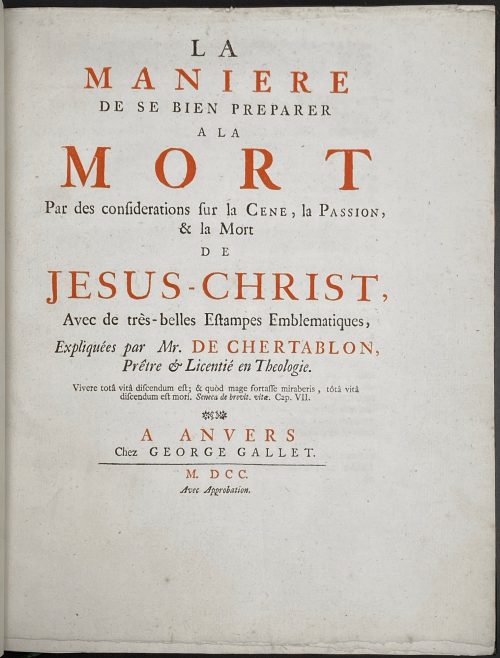 M. de Chertablon. La maniere de se bien preparer a la Mort par des Considerations sur la Cene, la Passion, et la Mort de Jesu-Christ. – Antwerp: George Gallet, 1700. Pagination: ff, [2 - blanks] [2 - t.p., blank] [3 - advert.] 4-63 [64]; 42 copper etched plates by Romeyn de Hooghe: A, B, C, 1-39; [20 - Dutch plate description of the David de la Vigne's Miroir de la bonne mort], bf. Full title: La maniere de se bien preparer a la Mort par des Considerations sur la Cene, la Passion, et la Mort de Jesu-Christ, Avec de très-belles Estampes Emblematiques, Expliquées par Mr. de Chertablon, Piêtre & Licentié en Theologie. Vivere totâ vitâ discendum est; & quòd mage fortasse miraberis, tôtâ vitâ discendum est mori. Seneca de brevit. vitæ. Cap. VII. A Anvers, Chez George Gallet. M DCC, Avec Approbation. / David de La Vigne. Spiegel om wel te sterven, annwyzende met beeltenissen van het lyden onses zaligmaakers Jesu Christi. Verzierd met 42 fyne Geërste Kopere Platen, Door Romain de Hooghe; Te Amsterdam, Voor dezen gedrukt by J. Stigter. Size: 4to, 27.2 x 21.6 cm. Binding: Late 19th century brown calf over marbled boards, spine with gilt lettering, raised bands, double fillet blind panels in compartments; marbled end-papers; bookplate of Samuel Ashton Thompson Yates library, AD 1894. Book illustrated with 42 copperplate etched engravings by Romeyn de Hooghe (Dutch, Amsterdam 1645–1708 Haarlem). According to Bonhams: the plates were "first printed for David de la Vigne's Miroir de la bonne mort. Each of the plates depicts a man contemplating a religious image in order to ease the passing of death, accompanied by commentary and an appropriate verse of scripture for each plate. The present French edition is bound with, as issued, the Dutch translation of David de La Vigne's aforementioned work."
M. de Chertablon. La maniere de se bien preparer a la Mort par des Considerations sur la Cene, la Passion, et la Mort de Jesu-Christ. – Antwerp: George Gallet, 1700. Pagination: ff, [2 - blanks] [2 - t.p., blank] [3 - advert.] 4-63 [64]; 42 copper etched plates by Romeyn de Hooghe: A, B, C, 1-39; [20 - Dutch plate description of the David de la Vigne's Miroir de la bonne mort], bf. Full title: La maniere de se bien preparer a la Mort par des Considerations sur la Cene, la Passion, et la Mort de Jesu-Christ, Avec de très-belles Estampes Emblematiques, Expliquées par Mr. de Chertablon, Piêtre & Licentié en Theologie. Vivere totâ vitâ discendum est; & quòd mage fortasse miraberis, tôtâ vitâ discendum est mori. Seneca de brevit. vitæ. Cap. VII. A Anvers, Chez George Gallet. M DCC, Avec Approbation. / David de La Vigne. Spiegel om wel te sterven, annwyzende met beeltenissen van het lyden onses zaligmaakers Jesu Christi. Verzierd met 42 fyne Geërste Kopere Platen, Door Romain de Hooghe; Te Amsterdam, Voor dezen gedrukt by J. Stigter. Size: 4to, 27.2 x 21.6 cm. Binding: Late 19th century brown calf over marbled boards, spine with gilt lettering, raised bands, double fillet blind panels in compartments; marbled end-papers; bookplate of Samuel Ashton Thompson Yates library, AD 1894. Book illustrated with 42 copperplate etched engravings by Romeyn de Hooghe (Dutch, Amsterdam 1645–1708 Haarlem). According to Bonhams: the plates were "first printed for David de la Vigne's Miroir de la bonne mort. Each of the plates depicts a man contemplating a religious image in order to ease the passing of death, accompanied by commentary and an appropriate verse of scripture for each plate. The present French edition is bound with, as issued, the Dutch translation of David de La Vigne's aforementioned work." -
 Ogata Gekkō [尾形月耕] (Japanese, 1859 – 1920). An uchiwa-e (fan-print) of advertisement of tobacco of Kagoshima Prefecture, c. 1890 (Meiji Period). Barefoot Tengu* is sitting on a torii (entrance to a Shinto shrine), smoking a cigarette through a mouthpiece. _______ * Tengu [天狗] (heavenly dog) is a type of legendary creature found in Japanese folk religion and are also considered a type of Shinto god (kami) or yōkai (supernatural beings).
Ogata Gekkō [尾形月耕] (Japanese, 1859 – 1920). An uchiwa-e (fan-print) of advertisement of tobacco of Kagoshima Prefecture, c. 1890 (Meiji Period). Barefoot Tengu* is sitting on a torii (entrance to a Shinto shrine), smoking a cigarette through a mouthpiece. _______ * Tengu [天狗] (heavenly dog) is a type of legendary creature found in Japanese folk religion and are also considered a type of Shinto god (kami) or yōkai (supernatural beings). -
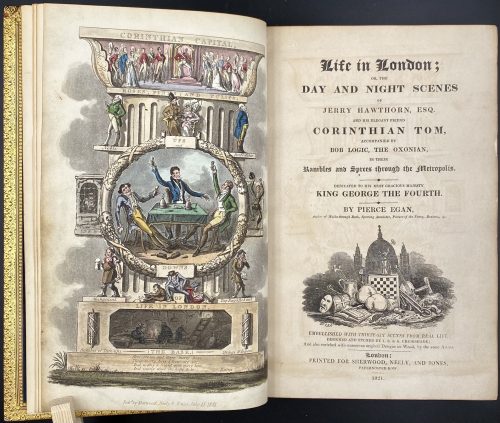
Title: Life in London ; | DAY AND NIGHT SCENES | OF | JERRY HAWTHORN, ESQ. | AND HIS ELEGANT FRIEND | CORINTHIAN TOM, | ACCOMPANIED BY | BOB LOGIC, THE OXONIAN, | IN THEIR |Rambles and Sprees through the Metropolis. | DEDICATED TO HIS MOST GRACIOUS MAJESTY | KING GEORGE THE FOURTH. | BY PIERCE EGAN, | Author of Walks through Bath, Sporting Anecdotes, Picture of the Fancy, Boxiana, &c. | [Vignette] | EMBELLISHED WITH THIRTY-SIX SCENES FROM REAL LIFE, | DESIGNED AND ETCHED BY I. R. & G. CRUIKSHANK ; | And also enriched with numerous original Designs on Wood, by the same Artists, | London: | PRINTED FOR SHERWOOD, NEELY, AND JONES, | PATERNOSTER-ROW. | 1821. ||
Edition: 1st edition, 1st issue: the first sheet of music is not numbered, absence of any footnote at page 9 (as per Cohn).
Pagination: 3 binder's flyleaves with a specimen of George Cruikshank's signature of Nov. 5th, 1860 to the first one; hand-coloured aquatint frontispiece facing the title page with blank recto, [iii-iv] – t.p. with vignette/ blank, [v] vi-viii – dedication, ix-xii – contents, [xiii]-xvi – list of illustrations; [1] 2-376; 35 hand-coloured aquatints, 3 folding leaves of music; bound without half-title [missing pp. i, ii], advertisements or 'to the subscribers' leaf.
Collation: 8vo; [A]7 B-Z8 Aa8-Bb4.
Binding: Full polished calf gilt by Rivière & Son, covers with triple gilt border, spine in 6 compartments, brown morocco lettering pieces to second and third, others richly gilt, raised bands, all edges gilt; neatly re-backed preserving spine.
Catalogue raisonné: Albert M. Cohn, 1924: № 262 p. 90; Abbey, J. R. (Life in England), 281; Tooley (Some English Books with Coloured Plates) 196; Prideaux (Aquatint Engraving) pp. 307, 310; Hardie (English coloured books) 197.
Description of Shapero Rare Books, London: There was a translation into French. At least six plays were based on Egan's characters, contributing to yet more sales. One of these was exported to America, launching the Tom and Jerry craze there. The version created by William Thomas Moncrieff was praised as The Beggar's Opera of its day. Moncrieff's production of Tom and Jerry, or Life in London ran continuously at the Adelphi Theatre for two seasons and it was the dramatist's work as much as the author's that did so much to popularise the book's trademark use of fashionable slang. In 1821 Egan announced the publication of a regular journal: Life in London, appearing monthly at a shilling a time. It was to be illustrated by George Cruikshank (1792 – 1878), and was dedicated to the King, George IV, who at one time had received Egan at court. The first edition of Life in London appeared on 15 July 1821. Egan's creation was an instant success. Pirate versions appeared, featuring such figures as 'Bob Tallyho', 'Dick Wildfire' and the like. Printmakers speedily knocked off cuts featuring the various 'stars' and the real-life public flocked to the 'sporting' addresses that Egan had his heroes frequent. -
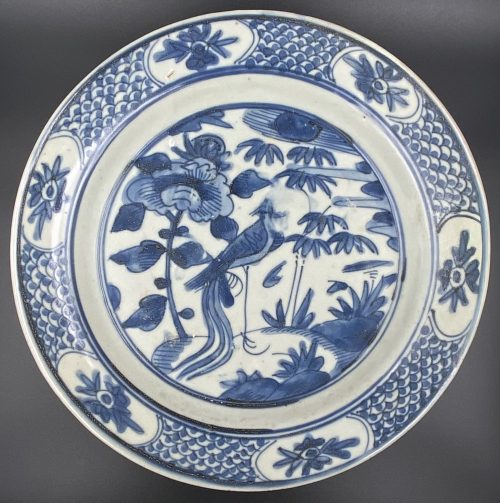 Underglaze cobalt blue and white Zhangzhou (Swatow) porcelain plate decorated vigorously and spontaneously with a bird in the landscape, and flowers in oval cartouches among waves or fish scale diaper. Sand particles on the base. Ming Dynasty [大明] (1368 – 1644); Wanli Era (1572 – 1620); Late 16th – Early 17th century. Diameter: 28.2 cm; Height: 4.0 cm
Underglaze cobalt blue and white Zhangzhou (Swatow) porcelain plate decorated vigorously and spontaneously with a bird in the landscape, and flowers in oval cartouches among waves or fish scale diaper. Sand particles on the base. Ming Dynasty [大明] (1368 – 1644); Wanli Era (1572 – 1620); Late 16th – Early 17th century. Diameter: 28.2 cm; Height: 4.0 cm -
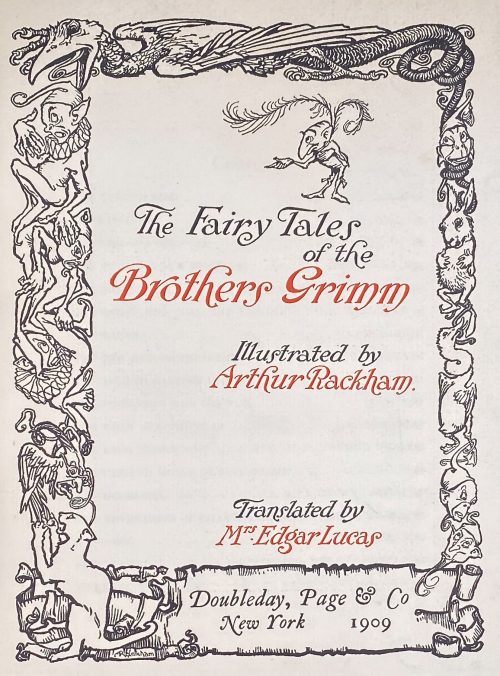 Title (black and red in pictorial frame): The Fairy Tales | of the | Brothers Grimm | Illustrated by Arthur Rackham. | Translated by | Mrs. Edgar Lucas | Doubleday, Page & Co | New York 1909. Pagination: [i-iv] – h.t., t.p., frontis., v-xv [xvi], 1-325 [326] colophon., [1 blank sheet], bfl; 40 tipped-in color plates (offset chromolithograph) with lettered guards, numerous in-text woodcuts. Collation: 4to; a-b4, A-2S4. Edition: 1st deluxe American large-paper edition, limited to 50 copies, Rackham’s facsimile signature to h.t. verso. Binding: Original full limp suede binding with yapp edges, gilt-ornamented and lettered spine. Top edge gilt, other uncut. Moiré endpapers. Printed on laid paper. Marbled endpapers.
Title (black and red in pictorial frame): The Fairy Tales | of the | Brothers Grimm | Illustrated by Arthur Rackham. | Translated by | Mrs. Edgar Lucas | Doubleday, Page & Co | New York 1909. Pagination: [i-iv] – h.t., t.p., frontis., v-xv [xvi], 1-325 [326] colophon., [1 blank sheet], bfl; 40 tipped-in color plates (offset chromolithograph) with lettered guards, numerous in-text woodcuts. Collation: 4to; a-b4, A-2S4. Edition: 1st deluxe American large-paper edition, limited to 50 copies, Rackham’s facsimile signature to h.t. verso. Binding: Original full limp suede binding with yapp edges, gilt-ornamented and lettered spine. Top edge gilt, other uncut. Moiré endpapers. Printed on laid paper. Marbled endpapers. -
![Henri Rollin. L'apocalypse de notre temps / Les dessous de la propagande allemande d'après des documents inédits. — NRF [Nouvelle Revue Française], — Paris: Gallimard, 1939. — Series: Problémes et documents. pp.: [1-9] 10-567 [9].](https://varshavskycollection.com/wp-content/uploads/2021/02/LIB-0371.2015-a-500x801.jpeg) Title: PROBLÈMES ET DOCUMENTS | HENRI ROLLIN | L'APOCALYPSE | DE | NOTRE TEMPS | Les dessous de la propagande allemande | d'après des documents inédits | nrf | S. P. | GALLIMARD | Paris — 43, rue de Beaune Pagination: [1-9] 10-567 [9]. Size: 22.6 x 14.2 cm Binding: original publisher's wrappers. Ex libris Lorenzo Grazzini of Librairie Scritti (book store in Paris). Publishing Year: 1939; Publisher: Gallimard; Acheve d'impremier - Le 23 Septembre 1939 par l'Impremierie Orleanaise 68, rue Royale, Orleans.
Title: PROBLÈMES ET DOCUMENTS | HENRI ROLLIN | L'APOCALYPSE | DE | NOTRE TEMPS | Les dessous de la propagande allemande | d'après des documents inédits | nrf | S. P. | GALLIMARD | Paris — 43, rue de Beaune Pagination: [1-9] 10-567 [9]. Size: 22.6 x 14.2 cm Binding: original publisher's wrappers. Ex libris Lorenzo Grazzini of Librairie Scritti (book store in Paris). Publishing Year: 1939; Publisher: Gallimard; Acheve d'impremier - Le 23 Septembre 1939 par l'Impremierie Orleanaise 68, rue Royale, Orleans. -
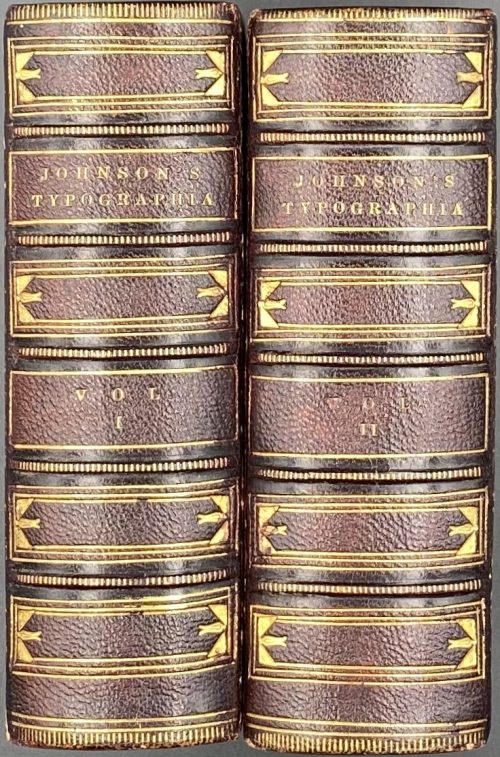 2 volume set, ¾ burgundy morocco over peacock marbled boards, ruled gilt, raised bands, gilt-ruled in compartments, gilt lettering, marbled endpapers and all margins, binding by W. S. Hiltz, NY. Vol. 1. Title: Typographia, | OR THE | Printers' Instructor: | INCLUDING AN ACCOUNT | of the | ORIGIN OF PRINTING, | with | Biographical Notices of the Printers of | England, from Caxton to the close | of the Sixteenth Century : | A Series of | Ancient and Modern Alphabets, | and | DOMESDAY CHARACTERS: | Together with | An Elucidation of every Subject con- | nected with the Art. | By J. JOHNSON, Printer. |{stanza}| Vol. I. | In frame: Published by Messrs. Longman, Hurst, | Rees, Orme, Brown & Green, Pater- | noster Row, London | Under the frame: 1824. || Pagination: Blank leaf, [2] – blank / engraved frontispiece (portrait of William Caxton by W. Hughes) w/guard, [2] – engraved t.p. by Thompson (upper margin almost none, tall lower margin, unframed) / blank, letterpress t.p. w/guard / blank, [2] – dedication to Earl Spenser and Roxburghe Club members / list of members, [2] – engraved Roxburgh Club plate by W. Hughes / blank, [4] – the pedigree of Earl Spenser, [i] ii-xii preface, [1] 2-610, [10] – index, blank leaf; printed on wove paper, text within double rule border. Vol. 2. Title: Typographia, | OR THE | Printers' Instructor: | INCLUDING AN ACCOUNT | of the | ORIGIN OF PRINTING, | with | Biographical Notices of the Printers of | England, from Caxton to the close | of the Sixteenth Century : | A Series of | Ancient and Modern Alphabets, | and | DOMESDAY CHARACTERS: | Together with | An Elucidation of every Subject con- | nected with the Art. | By J. JOHNSON, Printer. |{stanza}| Vol. II. | In frame: Published by Messrs. Longman, Hurst, | Rees, Orme, Brown & Green, Pater- | noster Row, London | Under the frame: 1824. || Pagination: Blank leaf, [2] – blank / engraved frontispiece (portrait of John Johnson ÆTATIS XLVI by William Harvey), w/o guard, [2] – engraved t.p. by G. W. Bonner (framed) / blank, letterpress t.p. w/o guard / blank, [2] – advert. / explanation of engraved title, [i]-iv contents, [1, 2] 3-663 [664], [14] – index, [2] – cantata, blank leaf; printed on wove paper, text within double rule border. Note: This is the book that served as a source of plagiarism for Adams's Typographia: a brief sketch of the origin, rise, and progress of the typographic art published in Philadelphia by himself in 1837.
2 volume set, ¾ burgundy morocco over peacock marbled boards, ruled gilt, raised bands, gilt-ruled in compartments, gilt lettering, marbled endpapers and all margins, binding by W. S. Hiltz, NY. Vol. 1. Title: Typographia, | OR THE | Printers' Instructor: | INCLUDING AN ACCOUNT | of the | ORIGIN OF PRINTING, | with | Biographical Notices of the Printers of | England, from Caxton to the close | of the Sixteenth Century : | A Series of | Ancient and Modern Alphabets, | and | DOMESDAY CHARACTERS: | Together with | An Elucidation of every Subject con- | nected with the Art. | By J. JOHNSON, Printer. |{stanza}| Vol. I. | In frame: Published by Messrs. Longman, Hurst, | Rees, Orme, Brown & Green, Pater- | noster Row, London | Under the frame: 1824. || Pagination: Blank leaf, [2] – blank / engraved frontispiece (portrait of William Caxton by W. Hughes) w/guard, [2] – engraved t.p. by Thompson (upper margin almost none, tall lower margin, unframed) / blank, letterpress t.p. w/guard / blank, [2] – dedication to Earl Spenser and Roxburghe Club members / list of members, [2] – engraved Roxburgh Club plate by W. Hughes / blank, [4] – the pedigree of Earl Spenser, [i] ii-xii preface, [1] 2-610, [10] – index, blank leaf; printed on wove paper, text within double rule border. Vol. 2. Title: Typographia, | OR THE | Printers' Instructor: | INCLUDING AN ACCOUNT | of the | ORIGIN OF PRINTING, | with | Biographical Notices of the Printers of | England, from Caxton to the close | of the Sixteenth Century : | A Series of | Ancient and Modern Alphabets, | and | DOMESDAY CHARACTERS: | Together with | An Elucidation of every Subject con- | nected with the Art. | By J. JOHNSON, Printer. |{stanza}| Vol. II. | In frame: Published by Messrs. Longman, Hurst, | Rees, Orme, Brown & Green, Pater- | noster Row, London | Under the frame: 1824. || Pagination: Blank leaf, [2] – blank / engraved frontispiece (portrait of John Johnson ÆTATIS XLVI by William Harvey), w/o guard, [2] – engraved t.p. by G. W. Bonner (framed) / blank, letterpress t.p. w/o guard / blank, [2] – advert. / explanation of engraved title, [i]-iv contents, [1, 2] 3-663 [664], [14] – index, [2] – cantata, blank leaf; printed on wove paper, text within double rule border. Note: This is the book that served as a source of plagiarism for Adams's Typographia: a brief sketch of the origin, rise, and progress of the typographic art published in Philadelphia by himself in 1837. -
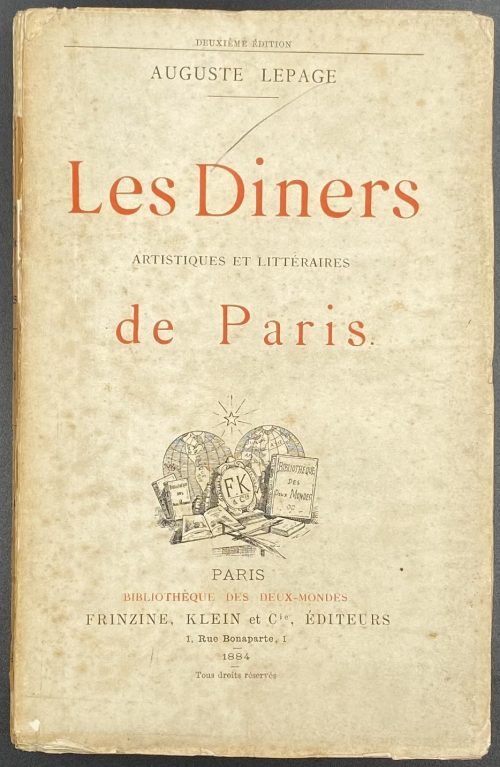 Cover: Publisher's wrappers, to front cover with black and red lettering: DEUXIÈME ÉDITION |—| AUGUSTE LEPAGE | Les Diners | ARTISTIQUES ET LITTÉRAIRES | de Paris | {publisher's device} | PARIS | BIBLIOTHÈQUE DES DEAUX MONDES| FRINZINE, KLEIN et Cie, ÉDIREURS | 1, RUE BONAPARTE, 1 | 1884 | Tous droits réservés || Title page: Similar lettering t.p. in black only, with "DEUXIÈME ÉDITION" below "de Paris". Pagination: front wrapper with a pasted leaf, [iii-vii] viii-xi [xii] [1-3] 4-360, back wrapper with a pasted 3/4 leaf, black lattering to spine. Collation: 18mo; π5, 1-1918-206.
Cover: Publisher's wrappers, to front cover with black and red lettering: DEUXIÈME ÉDITION |—| AUGUSTE LEPAGE | Les Diners | ARTISTIQUES ET LITTÉRAIRES | de Paris | {publisher's device} | PARIS | BIBLIOTHÈQUE DES DEAUX MONDES| FRINZINE, KLEIN et Cie, ÉDIREURS | 1, RUE BONAPARTE, 1 | 1884 | Tous droits réservés || Title page: Similar lettering t.p. in black only, with "DEUXIÈME ÉDITION" below "de Paris". Pagination: front wrapper with a pasted leaf, [iii-vii] viii-xi [xii] [1-3] 4-360, back wrapper with a pasted 3/4 leaf, black lattering to spine. Collation: 18mo; π5, 1-1918-206. -
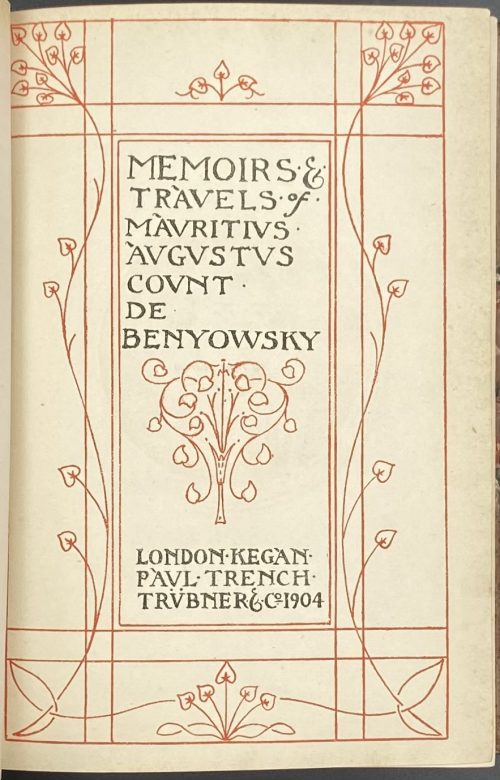 Title: MEMOIRS AND TRAVELS | OF | MAURITIUS AUGUSTUS COUNT DE | BENYOWSKY | MAGNATE OF THE KINGDOMS OF HUNGARY AND POLAND, ONE OF | THE CHIEFS OF THE CONFEDERATION OF POLAND | ETC., ETC. | Consisting of his Military Operations in Poland, his Exile into Kamchatka, | his Escape and Voyage from that Peninsula through the Northern | Pacific Ocean, touching at Japan and Formosa, to Canton | in China, with an Account of the French Settle- | ment he was appointed to form upon the | Island of Madagascar | WITH AN INTRODUCTION, NOTES AND BIBLIOGRAPHY | BY | CAPTAIN S. PASFIELD OLIVER || Half-title (ornamental, in black and red): MEMOIRS & | TRAVELS of | MAURITIUS | AUGUSTUS | COUNT | DE | BENYOWSKY | LONDON•KEGAN• | PAUL•TRENCH• | TRÜBNER•&•Co 1904 || Pagination: [i, ii] – owner pasted wood engraving “A woman of Kamchatka” / Dryden House advert., [iii, iv] – serial title / MAB (years), frontis. Portrait of MAB by Walter L. Colls w/guard, [v, vi] – ornamental h.t / copyright, [vii, viii] – t.p. / list of ill., ix-xxxvi, 1-635 [636]. Collation: 2 blank leaves (binding), [a]-b8 c2 1-398 406, 2 plates, 2 blank leaves (binding). Binding: Modern ¾ morocco over marbled boards, raised bands, gilt fleur-de-lis-cross in compartments, burgundy label with gilt lettering, by Atkinson Book Binders, Salisbury (sticker to back pastedown). Contributors: Printed by Neill and Co., Edinburgh. Published by Kegan Paul, Trench, Trübner & Co.; Kegan Paul, Charles (British, 1828 – 1902). Author: Maurice Auguste comte de Benyowsky [Мориц Август Бенёвский] (Polish-Slovak-Hungarian, 1746 –1786). Editor: Samuel Pasfield Oliver (British, 1838 – 1907). Translator: William Nicholson (British, 1753 – 1815). Originally published in 1790, in London (I have not seen it anywhere) and in Dublin by P. Wogan [etc.], and in 1791 in French, in Paris by Buisson.
Title: MEMOIRS AND TRAVELS | OF | MAURITIUS AUGUSTUS COUNT DE | BENYOWSKY | MAGNATE OF THE KINGDOMS OF HUNGARY AND POLAND, ONE OF | THE CHIEFS OF THE CONFEDERATION OF POLAND | ETC., ETC. | Consisting of his Military Operations in Poland, his Exile into Kamchatka, | his Escape and Voyage from that Peninsula through the Northern | Pacific Ocean, touching at Japan and Formosa, to Canton | in China, with an Account of the French Settle- | ment he was appointed to form upon the | Island of Madagascar | WITH AN INTRODUCTION, NOTES AND BIBLIOGRAPHY | BY | CAPTAIN S. PASFIELD OLIVER || Half-title (ornamental, in black and red): MEMOIRS & | TRAVELS of | MAURITIUS | AUGUSTUS | COUNT | DE | BENYOWSKY | LONDON•KEGAN• | PAUL•TRENCH• | TRÜBNER•&•Co 1904 || Pagination: [i, ii] – owner pasted wood engraving “A woman of Kamchatka” / Dryden House advert., [iii, iv] – serial title / MAB (years), frontis. Portrait of MAB by Walter L. Colls w/guard, [v, vi] – ornamental h.t / copyright, [vii, viii] – t.p. / list of ill., ix-xxxvi, 1-635 [636]. Collation: 2 blank leaves (binding), [a]-b8 c2 1-398 406, 2 plates, 2 blank leaves (binding). Binding: Modern ¾ morocco over marbled boards, raised bands, gilt fleur-de-lis-cross in compartments, burgundy label with gilt lettering, by Atkinson Book Binders, Salisbury (sticker to back pastedown). Contributors: Printed by Neill and Co., Edinburgh. Published by Kegan Paul, Trench, Trübner & Co.; Kegan Paul, Charles (British, 1828 – 1902). Author: Maurice Auguste comte de Benyowsky [Мориц Август Бенёвский] (Polish-Slovak-Hungarian, 1746 –1786). Editor: Samuel Pasfield Oliver (British, 1838 – 1907). Translator: William Nicholson (British, 1753 – 1815). Originally published in 1790, in London (I have not seen it anywhere) and in Dublin by P. Wogan [etc.], and in 1791 in French, in Paris by Buisson. -
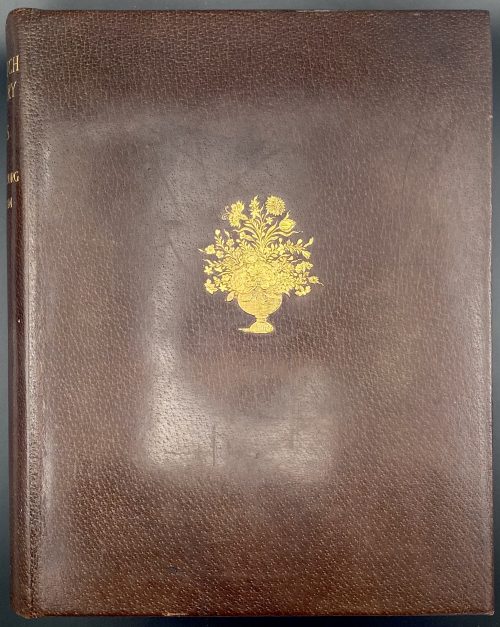 Title: OLD DUTCH | POTTERY AND TILES | BY ELISABETH | NEURDENBURG | LITT. D., READER IN THE HISTORY OF ART AT | THE UNIVERSITY OF GRONINGEN. TRANSLATED | WITH ANNOTATIONS BY | Bernard Rackham | DEPUTY KEEPER, DEPARTMENT | OF CERAMICS, VICTORIA AND | ALBERT MUSEUM | […] | WITH ONE HUNDRED AND TWELVE | ILLUSTRATIONS OF WHICH NINE | ARE IN COLOUR | LONDON: BENN BROTHERS, LIMITED | 8 BOUVERIE STREET, E.C. 4 | 1923 || Verso to half-title: Of this book 100 copies only for sale have been printed on English | hand-made paper, bound in pigskin and signed by the Authoress | and Translator. These copies also contain an extra colour plate. | This in Number “7” (in manuscript) | Two signatures (ink, manuscript) || Pagination: [i, ii] – h.t. / tirage, [iii, iv] – t.p. / imprint, [v, vi] – dedication to Dr. A. Pit / blank, vii-xv [xvi blank] [1, 2] 3-155 [156 blank], frontispiece (colour) and 59 leaves of plates (9 colour) with 112 figures, with lettered protective sheets. Collation: 4to in 8th; [A]8 [B]8 C-K8 L6; frontis., +59 leaves of plates. Binding: 30 x 24 cm, Full dark brown pigskin with gilt ornament to front board and gilt lettering to spine; printed on thick wove paper, top edge gilt, others untrimmed. Contributors: Neurdenburg, Elisabeth (Dutch, 1882 – 1957) – author [autograph]. Rackham, Bernard (British, 1876 – 1964) – translator [autograph]. Brendon, William (British, 1845 – 1928) – printer. Mayflower Press (Plymouth), William Brendon & Son, Ltd. – printer Benn Brothers Ltd. (British company, 1880 – 1987) Benn, Sir John, 1st Baronet (British, 1850 – 1922)
Title: OLD DUTCH | POTTERY AND TILES | BY ELISABETH | NEURDENBURG | LITT. D., READER IN THE HISTORY OF ART AT | THE UNIVERSITY OF GRONINGEN. TRANSLATED | WITH ANNOTATIONS BY | Bernard Rackham | DEPUTY KEEPER, DEPARTMENT | OF CERAMICS, VICTORIA AND | ALBERT MUSEUM | […] | WITH ONE HUNDRED AND TWELVE | ILLUSTRATIONS OF WHICH NINE | ARE IN COLOUR | LONDON: BENN BROTHERS, LIMITED | 8 BOUVERIE STREET, E.C. 4 | 1923 || Verso to half-title: Of this book 100 copies only for sale have been printed on English | hand-made paper, bound in pigskin and signed by the Authoress | and Translator. These copies also contain an extra colour plate. | This in Number “7” (in manuscript) | Two signatures (ink, manuscript) || Pagination: [i, ii] – h.t. / tirage, [iii, iv] – t.p. / imprint, [v, vi] – dedication to Dr. A. Pit / blank, vii-xv [xvi blank] [1, 2] 3-155 [156 blank], frontispiece (colour) and 59 leaves of plates (9 colour) with 112 figures, with lettered protective sheets. Collation: 4to in 8th; [A]8 [B]8 C-K8 L6; frontis., +59 leaves of plates. Binding: 30 x 24 cm, Full dark brown pigskin with gilt ornament to front board and gilt lettering to spine; printed on thick wove paper, top edge gilt, others untrimmed. Contributors: Neurdenburg, Elisabeth (Dutch, 1882 – 1957) – author [autograph]. Rackham, Bernard (British, 1876 – 1964) – translator [autograph]. Brendon, William (British, 1845 – 1928) – printer. Mayflower Press (Plymouth), William Brendon & Son, Ltd. – printer Benn Brothers Ltd. (British company, 1880 – 1987) Benn, Sir John, 1st Baronet (British, 1850 – 1922) -
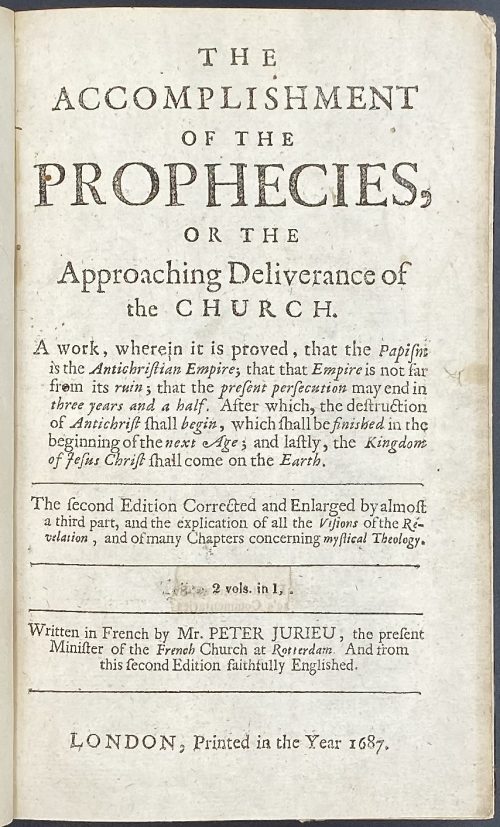 Title page (with tall “s”): THE | ACCOMPLISHMENT | OF THE | PROPHECIES, | OR THE | Approaching Deliverance of | the CHURCH. | A work, wherein it is proved, that the Papism | is the Antichristian Empire; that that Empire is not far | from its ruin ; that the present persecution may end in | three years and a half. After which, the destruction | of Antichrist shall begin, which shall be finished in the | beginning of the next Age ; and lastly, the Kingdom | of Jesus Christ shall come on the Earth. | — | The second Edition Corrected and Enlarged by almost | a third part, and the explication of all the Visions of the Re- | velation, and of many Chapters concerning mystical Theology. | — | 2 vols. In 1, | — | Written in French by Mr. PETER JURIEU , the present | Minister of the French Church at Rotterdam. And from | this second Edition faithfully Englished. | — | LONDON , Printed in the Year 1687. || Pagination: ffl, [48] 1-271 [272 blank] + 3-99, 200-396, bfl. Note: part 2 starts with page 3, page 99 recto is paginated 200 on verso, instead of 100; total number of pages in part 2, thus, is 294. Collation is uninterrupted. Collation: *-**8 A-S8 + Aa7 Bb-Ss8 Tt4. Note: no leaf Aa1, leaf Tt4 unsigned; 307 leaves total. Binding: Full brown calf, boards ruled blind with double-fillet, flat spine stamped blind with a diaper, double-fillet ruled compartments, black label with gilt lettering. Printed on laid paper, with marginal notes. Yellow sticker to front pastedown G. Batenham, Bookseller, Northgate, Chester. Author: Pierre Jurieu (French, 1637 – 1713). Translator unknown. Publisher unknown.
Title page (with tall “s”): THE | ACCOMPLISHMENT | OF THE | PROPHECIES, | OR THE | Approaching Deliverance of | the CHURCH. | A work, wherein it is proved, that the Papism | is the Antichristian Empire; that that Empire is not far | from its ruin ; that the present persecution may end in | three years and a half. After which, the destruction | of Antichrist shall begin, which shall be finished in the | beginning of the next Age ; and lastly, the Kingdom | of Jesus Christ shall come on the Earth. | — | The second Edition Corrected and Enlarged by almost | a third part, and the explication of all the Visions of the Re- | velation, and of many Chapters concerning mystical Theology. | — | 2 vols. In 1, | — | Written in French by Mr. PETER JURIEU , the present | Minister of the French Church at Rotterdam. And from | this second Edition faithfully Englished. | — | LONDON , Printed in the Year 1687. || Pagination: ffl, [48] 1-271 [272 blank] + 3-99, 200-396, bfl. Note: part 2 starts with page 3, page 99 recto is paginated 200 on verso, instead of 100; total number of pages in part 2, thus, is 294. Collation is uninterrupted. Collation: *-**8 A-S8 + Aa7 Bb-Ss8 Tt4. Note: no leaf Aa1, leaf Tt4 unsigned; 307 leaves total. Binding: Full brown calf, boards ruled blind with double-fillet, flat spine stamped blind with a diaper, double-fillet ruled compartments, black label with gilt lettering. Printed on laid paper, with marginal notes. Yellow sticker to front pastedown G. Batenham, Bookseller, Northgate, Chester. Author: Pierre Jurieu (French, 1637 – 1713). Translator unknown. Publisher unknown.English translation of the book:Pierre Jurieu. L'accomplissement des Propheties ou la delivrance prochaine de l'Eglise. —Rotterdam: Acher, 1686.
-
![Манцони Алессандро. Обрученные. Повесть из истории Милана XVII века. Пер.и комм. И.И.Штица. Вст.ст А.К.Дживелегова. Илл. Е.Д.Белухи // Серия: Итальянская лит-ра. — М.-Л.: Academia, 1936. — XXXVIII, 952 стр., 15 илл. Тираж: 5300 экз. [том выходил без супера].](https://varshavskycollection.com/wp-content/uploads/2021/02/LIB-1333-a-500x670.jpg) Title page: АЛЕССАНДРО МАНЦОНИ | ОБРУЧЕННЫЕ | ПОВЕСТЬ ИЗ ИСТОРИИ | МИЛАНА XVII ВЕКА | ПЕРЕВОД И КОММЕНТАРИИ | И. И. ШИТЦА | ВСТУПИТЕЛЬНАЯ СТАТЬЯ | А. К ДЖИВЕЛЕГОВА | ACADEMIA | 1936 || Frontispiece: ИТАЛЬЯНСКАЯ ЛИТЕРАТУРА | ПОД ОБЩЕЙ РЕДАКЦИЕЙ А. К ДЖИВЕЛЕГОВА | АЛЕССАНДРО | МАНЦОНИ | 1785 — 1873 | ACADEMIA | МОСКВА ЛЕНИНГРАД || Title verso: ALESSANDRO MANZONI | I PROMESSI SPOSI | Иллюстрации — автолитография | Е. Д. Белухи | Титула и переплет | по его же рисунку || Pagination: [i-vii] viii-xxxviii [2] [2] 3-946 [8] + 15 leaves of illustrations. Collation: [I]8 II8 III4 1-598 ⅛605 + 5 leaves of plates + 10 leaves of plates (lithography by Е. Д. Белуха). Binding: 19.5 x 14.5 cm; Publisher’s blue cloth, lettering and design to cover and spine (by Е. Д. Белуха). Print run: 5300 copies. Catalogue raisonné: Крылов-Кичатова (2004): №832, p. 279. Contributors: Мандзони, Алессандро [Manzoni, Alessandro] (Italian, 1785 – 1873) – author of the original text. Шитц, Иван Иванович (Russian, 1874—1942) – translator from the Italian into Russian. Дживелегов, Алексей Карпович (Russian, 1875 – 1952) – editor. Белуха, Евгений Дмитриевич (Russian, 1889 – 1943) – artist. For the first English edition see: [LIB-1332.2017]: Alessandro Manzoni. The betrothed / (Standard novels). — London: R. Bentley, 1834.
Title page: АЛЕССАНДРО МАНЦОНИ | ОБРУЧЕННЫЕ | ПОВЕСТЬ ИЗ ИСТОРИИ | МИЛАНА XVII ВЕКА | ПЕРЕВОД И КОММЕНТАРИИ | И. И. ШИТЦА | ВСТУПИТЕЛЬНАЯ СТАТЬЯ | А. К ДЖИВЕЛЕГОВА | ACADEMIA | 1936 || Frontispiece: ИТАЛЬЯНСКАЯ ЛИТЕРАТУРА | ПОД ОБЩЕЙ РЕДАКЦИЕЙ А. К ДЖИВЕЛЕГОВА | АЛЕССАНДРО | МАНЦОНИ | 1785 — 1873 | ACADEMIA | МОСКВА ЛЕНИНГРАД || Title verso: ALESSANDRO MANZONI | I PROMESSI SPOSI | Иллюстрации — автолитография | Е. Д. Белухи | Титула и переплет | по его же рисунку || Pagination: [i-vii] viii-xxxviii [2] [2] 3-946 [8] + 15 leaves of illustrations. Collation: [I]8 II8 III4 1-598 ⅛605 + 5 leaves of plates + 10 leaves of plates (lithography by Е. Д. Белуха). Binding: 19.5 x 14.5 cm; Publisher’s blue cloth, lettering and design to cover and spine (by Е. Д. Белуха). Print run: 5300 copies. Catalogue raisonné: Крылов-Кичатова (2004): №832, p. 279. Contributors: Мандзони, Алессандро [Manzoni, Alessandro] (Italian, 1785 – 1873) – author of the original text. Шитц, Иван Иванович (Russian, 1874—1942) – translator from the Italian into Russian. Дживелегов, Алексей Карпович (Russian, 1875 – 1952) – editor. Белуха, Евгений Дмитриевич (Russian, 1889 – 1943) – artist. For the first English edition see: [LIB-1332.2017]: Alessandro Manzoni. The betrothed / (Standard novels). — London: R. Bentley, 1834. -
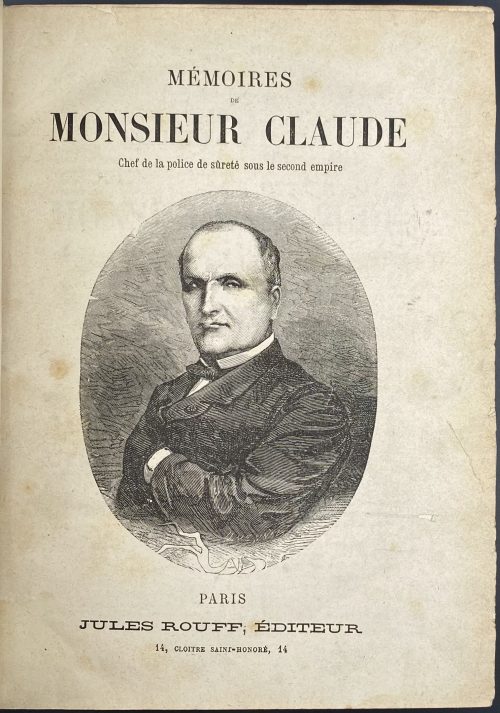 Vol. 1: Title: MÉMOIRES | DE | MONSIEUR CLAUDE | CHEF DE LA POLICE DE SURETÉ́ SOUS LE SECOND EMPIRE | {single rule} | PREMIER VOLUME | publisher’s device «JR» in oval} | PARIS | JULES ROUFF ET Cie, ÉDITEURS | 14, CLOITRE SAINT-HONORÉ, 14 | {single rule} || Pagination: [4] – h.t., t.p., [1-3] – engraved t.p. w/portrait, 3-800 [4], in-text and full-page woodcuts; last two leaves (table) has numbered pages 1000 and 1001; the total number of pages 808. Collation: 4to; π2 [1]4 2-1004 Ω2, woodcuts by Quesnel and Ferdinandus, within collation; the total number of leaves 404. Vol. 2: Title: Same but “DEUXIEME VOLUME” Pagination: [4] – h.t., t.p., [801-2] – frontis., 803-2010, [6] – assassinats, [4] – table, in-text and full-page woodcuts; last two leaves (table) has numbered pages 2018 and 2019; the total number of pages 1224. Collation: 4to; π2 101-2524 Ω2, woodcuts by Quesnel and Ferdinandus, within collation; the total number of leaves 612. Binding: Two volumes 28 x 20.5 cm each, uniformly bound in quarter polished brown calf over marbled boards, blind-stamped florets and gilt lettering to spine, marbled endpapers. Contributors: Claude, Antoine (French, 1807 – 1880) – declared author of the text. Labourieu, Théodore (French, 1822 – 1889) – assumed author of the text. Quesnel, Désiré Mathieu (French, 1843 – 1915) – woodcut printmaker. Ferdinandus, Alexandre [Avenet, François] (French, 1850 – 1888) – illustrator. D. Bardin et Cie – printer. Jules Rouff (French, 1846 – 1927) – publisher. Jules Rouff et Cie (Paris, 1873 – 1982) – publisher. Note: Common opinion is that the text was produced by Théodore Labourieu, not by, Antoine Claude. The first edition was published by the same publisher in 10 volumes in wrappers without illustrations, between 1880 and 1883, after the death of Antoine Claude. As stated in WorldCat: “not written or sanctioned by him.” This two-volume edition was published later, with multiple woodcuts.
Vol. 1: Title: MÉMOIRES | DE | MONSIEUR CLAUDE | CHEF DE LA POLICE DE SURETÉ́ SOUS LE SECOND EMPIRE | {single rule} | PREMIER VOLUME | publisher’s device «JR» in oval} | PARIS | JULES ROUFF ET Cie, ÉDITEURS | 14, CLOITRE SAINT-HONORÉ, 14 | {single rule} || Pagination: [4] – h.t., t.p., [1-3] – engraved t.p. w/portrait, 3-800 [4], in-text and full-page woodcuts; last two leaves (table) has numbered pages 1000 and 1001; the total number of pages 808. Collation: 4to; π2 [1]4 2-1004 Ω2, woodcuts by Quesnel and Ferdinandus, within collation; the total number of leaves 404. Vol. 2: Title: Same but “DEUXIEME VOLUME” Pagination: [4] – h.t., t.p., [801-2] – frontis., 803-2010, [6] – assassinats, [4] – table, in-text and full-page woodcuts; last two leaves (table) has numbered pages 2018 and 2019; the total number of pages 1224. Collation: 4to; π2 101-2524 Ω2, woodcuts by Quesnel and Ferdinandus, within collation; the total number of leaves 612. Binding: Two volumes 28 x 20.5 cm each, uniformly bound in quarter polished brown calf over marbled boards, blind-stamped florets and gilt lettering to spine, marbled endpapers. Contributors: Claude, Antoine (French, 1807 – 1880) – declared author of the text. Labourieu, Théodore (French, 1822 – 1889) – assumed author of the text. Quesnel, Désiré Mathieu (French, 1843 – 1915) – woodcut printmaker. Ferdinandus, Alexandre [Avenet, François] (French, 1850 – 1888) – illustrator. D. Bardin et Cie – printer. Jules Rouff (French, 1846 – 1927) – publisher. Jules Rouff et Cie (Paris, 1873 – 1982) – publisher. Note: Common opinion is that the text was produced by Théodore Labourieu, not by, Antoine Claude. The first edition was published by the same publisher in 10 volumes in wrappers without illustrations, between 1880 and 1883, after the death of Antoine Claude. As stated in WorldCat: “not written or sanctioned by him.” This two-volume edition was published later, with multiple woodcuts. -
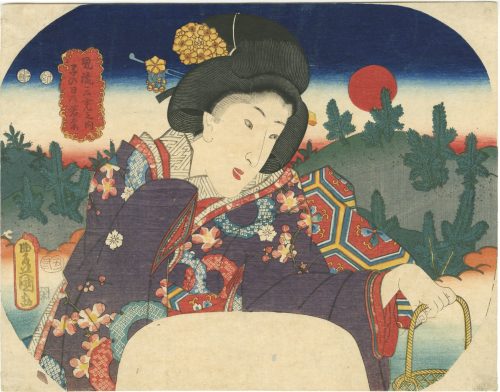 An uncut fan print shows a young woman holding a basket on a landscape background with hills and pines under a rising sun. Haruo Shirane: "Under the luni-solar calendar, the New Year coincided with the beginning of spring, making it the most important observance of the year for the aristocracy. In the Heian period, New Year ceremonies extended from New Year’s Day (Ganjitsu) to the Day of the Rat (Nenohi), which usually fell on the seventh day of the First Month, when courtiers went out to the fields (no), pulled up small pines, and gathered new herbs (wakana) as a prayer for long life. This ritual gradually spread to the provinces and to commoners, eventually resulting in the New Year practice of the gate pine (kadomatsu), in which a pair of small pines was placed at the gate of a house. A popular Heian-period painting topic representing the First Month was “prayers on the Day of the Rat” (Nenohi no asobi), which depicted the auspicious scene of pulling up small pines in a spring field. Both young herbs and gathering young herbs, particularly at Kasuga Field, became major poetic topics for the First Month, appearing in both the spring and celebration (ga) books of the Kokinshū (Collection of Japanese Poems Old and New, ca. 905). By the Kamakura period, the observance of the Day of the Rat had been abandoned at the imperial court, but the custom of gathering and eating young greens continued as the annual ceremony known as the Seven Grasses (Nanakusa). Note: The Heian-period ritual of pulling up the roots of small pines (komatsu ) on the first Day of the Rat derives from the homonyms ne (rat) and ne (root). Pulling up roots was auspicious, since it implied lengthening the year. The rising sun (hinode) was considered an auspicious sight, particularly at the beginning of the year". [Haruo Shirane, Japan and the Culture of the Four Seasons. Nature, Literature, and the Arts. — Columbia University, NY, 2012]. Title: Gathering of the young herbs on the Day of the Rat [子の日乃若菜] (Nenohi no wakana). Series: Three elegant sources of light [風流三光の内] (fūryū sankō no uchi); meaning the sun, the moon and the stars). Artist: Utagawa Kunisada [歌川 国貞]; a.k.a. Utagawa Toyokuni III [三代歌川豊国] (Japanese, 1786 – 1865). Signed: Toyokuni ga [豊国 画] in a yellow toshidama cartouche. Publisher’s seal: Izuzen (Marks: seal 06-029 | U103b) Date and double nanushi censor seals: Mera and Watanabe, Kaei 6 (1853). A similar theme can be found in Kunisadai's triptych published in about 1844 (HARA SHOBO):
An uncut fan print shows a young woman holding a basket on a landscape background with hills and pines under a rising sun. Haruo Shirane: "Under the luni-solar calendar, the New Year coincided with the beginning of spring, making it the most important observance of the year for the aristocracy. In the Heian period, New Year ceremonies extended from New Year’s Day (Ganjitsu) to the Day of the Rat (Nenohi), which usually fell on the seventh day of the First Month, when courtiers went out to the fields (no), pulled up small pines, and gathered new herbs (wakana) as a prayer for long life. This ritual gradually spread to the provinces and to commoners, eventually resulting in the New Year practice of the gate pine (kadomatsu), in which a pair of small pines was placed at the gate of a house. A popular Heian-period painting topic representing the First Month was “prayers on the Day of the Rat” (Nenohi no asobi), which depicted the auspicious scene of pulling up small pines in a spring field. Both young herbs and gathering young herbs, particularly at Kasuga Field, became major poetic topics for the First Month, appearing in both the spring and celebration (ga) books of the Kokinshū (Collection of Japanese Poems Old and New, ca. 905). By the Kamakura period, the observance of the Day of the Rat had been abandoned at the imperial court, but the custom of gathering and eating young greens continued as the annual ceremony known as the Seven Grasses (Nanakusa). Note: The Heian-period ritual of pulling up the roots of small pines (komatsu ) on the first Day of the Rat derives from the homonyms ne (rat) and ne (root). Pulling up roots was auspicious, since it implied lengthening the year. The rising sun (hinode) was considered an auspicious sight, particularly at the beginning of the year". [Haruo Shirane, Japan and the Culture of the Four Seasons. Nature, Literature, and the Arts. — Columbia University, NY, 2012]. Title: Gathering of the young herbs on the Day of the Rat [子の日乃若菜] (Nenohi no wakana). Series: Three elegant sources of light [風流三光の内] (fūryū sankō no uchi); meaning the sun, the moon and the stars). Artist: Utagawa Kunisada [歌川 国貞]; a.k.a. Utagawa Toyokuni III [三代歌川豊国] (Japanese, 1786 – 1865). Signed: Toyokuni ga [豊国 画] in a yellow toshidama cartouche. Publisher’s seal: Izuzen (Marks: seal 06-029 | U103b) Date and double nanushi censor seals: Mera and Watanabe, Kaei 6 (1853). A similar theme can be found in Kunisadai's triptych published in about 1844 (HARA SHOBO):
豊国三代「豊歳子日若菜摘ノ図」
-
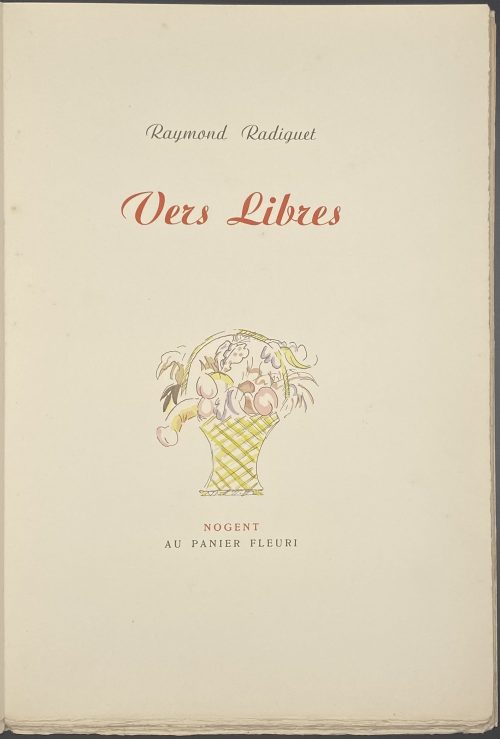 Unbound, unpaginated album (28.4 x 19.5 cm) with 24 leaves (12 folded sheets 28 x 38 cm each), printed on thick wove paper, watermarked Vidalon, with text and 31 vignettes, some pages foxed. Publisher’s original flapped cream wrappers, lettering to front: Raymond Radiguet | Vers Libres | {vignette} || Half-title: “Vers Libres” on a ribbon covering a stick, garland, and flute. Title: Raymond Radiguet | Vers Libres | {vignette} | NOGENT | AU PANIER FLEURI || Illustrations: Cover vignette, frontispiece, tail- and a headpiece for introduction, and vignettes (total 31 illustrations) undoubtedly attributed Rojan (Feodor Rojankovsky). Poems: Chat perché; Champigny, Les fiancés de treize ans, Saison, Le petit journal, Ébauches, Usée, Jeux innocents, Bains publics, L’autre bouche, Cinématographe. In 1937, the «Jeux innocents» piece was added to the 1935 edition, together with 4 illustrations on top of 27 vignettes in 1935, making it 31. Edition: 1st thus; however, the 1935 edition may be considered the 'real' 1st. Limitation on the last page: the total print run on 250 copies by subscription only, this copy is № 181 from 243 on Vélin de Vidalon (as per Dutel). Illustrations printed in black and stencil-coloured (au pochoir). Catalogue raisonné: Dutel 2593; Nordmann (2): 451. Contributors: Raymond Radiguet (French, 1903 – 1923) – author. Feodor Rojankovsky [Rojan; Рожанковский, Фёдор Степанович] (Russian-American, 1891 – 1970) – artist.
Unbound, unpaginated album (28.4 x 19.5 cm) with 24 leaves (12 folded sheets 28 x 38 cm each), printed on thick wove paper, watermarked Vidalon, with text and 31 vignettes, some pages foxed. Publisher’s original flapped cream wrappers, lettering to front: Raymond Radiguet | Vers Libres | {vignette} || Half-title: “Vers Libres” on a ribbon covering a stick, garland, and flute. Title: Raymond Radiguet | Vers Libres | {vignette} | NOGENT | AU PANIER FLEURI || Illustrations: Cover vignette, frontispiece, tail- and a headpiece for introduction, and vignettes (total 31 illustrations) undoubtedly attributed Rojan (Feodor Rojankovsky). Poems: Chat perché; Champigny, Les fiancés de treize ans, Saison, Le petit journal, Ébauches, Usée, Jeux innocents, Bains publics, L’autre bouche, Cinématographe. In 1937, the «Jeux innocents» piece was added to the 1935 edition, together with 4 illustrations on top of 27 vignettes in 1935, making it 31. Edition: 1st thus; however, the 1935 edition may be considered the 'real' 1st. Limitation on the last page: the total print run on 250 copies by subscription only, this copy is № 181 from 243 on Vélin de Vidalon (as per Dutel). Illustrations printed in black and stencil-coloured (au pochoir). Catalogue raisonné: Dutel 2593; Nordmann (2): 451. Contributors: Raymond Radiguet (French, 1903 – 1923) – author. Feodor Rojankovsky [Rojan; Рожанковский, Фёдор Степанович] (Russian-American, 1891 – 1970) – artist. -
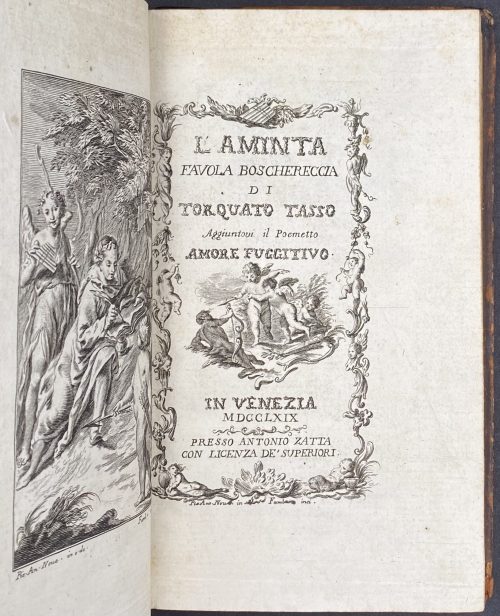 Engraved title-page: L'AMINTA | FAVOLA BOSCHERECCIA | DI | TORQUATO TASSO | Aggiuntovi il Poemetto | Amore Fugitivo |{vignette} | IN VENEZIA | MDCCLXIX |—| PRESSO ANTONIO ZATTA | CON LICENZA DE’ SUPERIORI || in historiated frame, signed below: “Pet. Ant. Novelli in — Fambrini inci.” Pagination: [i] ii-xxiv, [1-2] 3-84, total 108 pages, ils. Collation: 12mo; a12, A-C12 D6, last blank; first 6 leaves signed in 12-leave quires, first 3 in D; total 54 leaves plus 9 plates, incl. engraved title and frontispiece, and numerous head- and tailpieces by Fambrini after Novelli. Binding: 18.6 x 11 cm, contemporary tree calf, rebacked, crimson label with gilt lettering; clipping and bookplate of The Robin Collection to front pastedown; verso front flyleaf stamped “RESTORED BY MACDONALD CO. | NORWALK. CONN.” Additional blank leaves at front and back. Provenance: Satinsky, Robin F. (American, 1919 – 2008); The Robin Collection. Contributors: Torquato Tasso (Italian, 1544 –1595) – author. Pietro Antonio Novelli (Italian, 1729 – 1804) – artist. Ferdinando Fambrini (Italian (1764 – c.1793) – engraver. Antonio Zatta (Italian, c. 1722 – 1804) – printer, publisher.
Engraved title-page: L'AMINTA | FAVOLA BOSCHERECCIA | DI | TORQUATO TASSO | Aggiuntovi il Poemetto | Amore Fugitivo |{vignette} | IN VENEZIA | MDCCLXIX |—| PRESSO ANTONIO ZATTA | CON LICENZA DE’ SUPERIORI || in historiated frame, signed below: “Pet. Ant. Novelli in — Fambrini inci.” Pagination: [i] ii-xxiv, [1-2] 3-84, total 108 pages, ils. Collation: 12mo; a12, A-C12 D6, last blank; first 6 leaves signed in 12-leave quires, first 3 in D; total 54 leaves plus 9 plates, incl. engraved title and frontispiece, and numerous head- and tailpieces by Fambrini after Novelli. Binding: 18.6 x 11 cm, contemporary tree calf, rebacked, crimson label with gilt lettering; clipping and bookplate of The Robin Collection to front pastedown; verso front flyleaf stamped “RESTORED BY MACDONALD CO. | NORWALK. CONN.” Additional blank leaves at front and back. Provenance: Satinsky, Robin F. (American, 1919 – 2008); The Robin Collection. Contributors: Torquato Tasso (Italian, 1544 –1595) – author. Pietro Antonio Novelli (Italian, 1729 – 1804) – artist. Ferdinando Fambrini (Italian (1764 – c.1793) – engraver. Antonio Zatta (Italian, c. 1722 – 1804) – printer, publisher. -
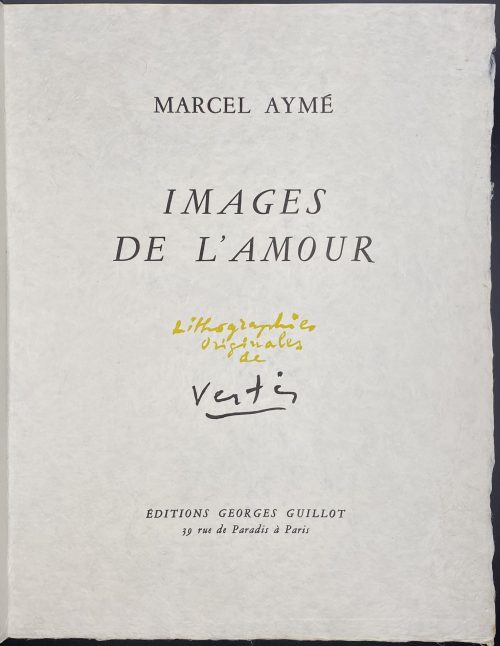 Title-page: MARCEL AYMÉ | IMAGES DE L'AMOUR | Lithographies | originales | de | Vertès (fac-simile ms) | ÉDITIONS GEORGES GUILLOT | 39 rue de Paradis à Paris || French flapped wrapper in a natural canvas double slipcase with gilt lettering to spine, 34.8 x 27.3 cm. Leaves 33 x 25.5 cm, 4 blanks at the beginning, to the second pair of leaves pasted two autograph letters signed by Marcel Aymé; [1-8] 9-119 [120] [6], last leaf blank, h.t. with inscription "En sincère hommage" signed by both Marcel Aymé and Marcel Vertès; 9 full-page chromolithographs, 6 headpieces and 2 tailpieces by Marcel Vertès, tissue-guards; in-4to, unbound. Printed on October 20, 1957. The edition is limited to 190 copies + 25 not for sale, this is copy № 1, printed on Japon Nacré paper and enriched with three additional suites of lithographs: one on Japon Nacré, one on Japon ancien, one on Hollande, plus a set of decomposition of one chromolithograph; lacking three original drawings. Contributors: Marcel Aymé (French, 1902 – 1967) – author. Marcel Vertès [Marcell Vértes] (Jewish-Hungarian-French, 1895 – 1961) – artist. Georges Guillot – publisher. Andrée Koch – designer. Fequet et Baudier – printers, typography. Edmond et Jacques Desjobert – lithographers. Other names: Marcel Vertès, Marcel Vertes, Marcell Vértes
Title-page: MARCEL AYMÉ | IMAGES DE L'AMOUR | Lithographies | originales | de | Vertès (fac-simile ms) | ÉDITIONS GEORGES GUILLOT | 39 rue de Paradis à Paris || French flapped wrapper in a natural canvas double slipcase with gilt lettering to spine, 34.8 x 27.3 cm. Leaves 33 x 25.5 cm, 4 blanks at the beginning, to the second pair of leaves pasted two autograph letters signed by Marcel Aymé; [1-8] 9-119 [120] [6], last leaf blank, h.t. with inscription "En sincère hommage" signed by both Marcel Aymé and Marcel Vertès; 9 full-page chromolithographs, 6 headpieces and 2 tailpieces by Marcel Vertès, tissue-guards; in-4to, unbound. Printed on October 20, 1957. The edition is limited to 190 copies + 25 not for sale, this is copy № 1, printed on Japon Nacré paper and enriched with three additional suites of lithographs: one on Japon Nacré, one on Japon ancien, one on Hollande, plus a set of decomposition of one chromolithograph; lacking three original drawings. Contributors: Marcel Aymé (French, 1902 – 1967) – author. Marcel Vertès [Marcell Vértes] (Jewish-Hungarian-French, 1895 – 1961) – artist. Georges Guillot – publisher. Andrée Koch – designer. Fequet et Baudier – printers, typography. Edmond et Jacques Desjobert – lithographers. Other names: Marcel Vertès, Marcel Vertes, Marcell Vértes
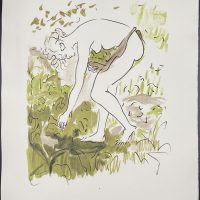


-
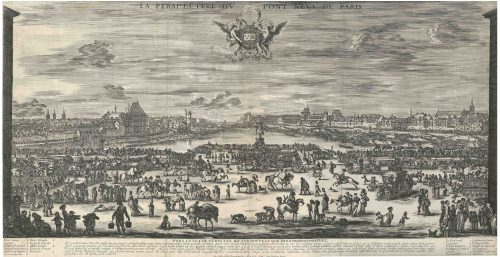
Etching on laid paper, backed. Massar (1971): 59-61. View of the Pont Neuf in Paris, with the statue of Henry IV at centre in front of the Seine, the church of St.-Germaine l'Auxerrois and the Louvre to the right, and the Hôtel de Nevers and Tour de Nesle to the left (MET). in the banner below: LUDOVICO XIIII GALLIARUM ET NAV REGI; below image: PONS LVTETIÆ STRVCTVS, DICTVS NOVVS, ET QVÆ EX EO PROSPICI POSSVNT.; bellow: En pulcherrimus toto ... caufatus, vifere; along the bottom: Ste. Della Bella Florentinus In. e Fecit DD. 1646. Cum Privilegio Regis; additional lettering a lower left and right identifying places depicted.
State: 2nd, with the weathercock on the belltower of Église Saint-Germain l'Auxerrois (under 8). Size: 35.5 x 67.6 cm. Condition: Three vertical folds, these partly cracked and backed at the bottom, dusty or slightly stained, partly slightly rubbed, a small diagonal crease on the upper left, tiny marginal blemishes.Quotation from Phyllis D. Massar. Presenting Stefano della Bella. — NY: The Metropolitan Museum of Art, [1971]: "For size and complexity, one of Della Bella's most impressive achievements is his view of Paris across the Pont Neuf from a point between the buildings bounding the Place Dauphine. Besides the well-known landmarks-the Hộtel de Nevers, the Tour de Nesle, the church of Saint Germain l'Auxerrois, and, at the centre, the bronze equestrian statue of Henri IV by the Florentines Giovanni Bologna and Pietro Tacca – the print provides a microcosm of Paris in transit across the Seine. With a glass, one can compile a census of 451 people, thirty-eight horses, nineteen dogs, three donkeys, and one lamb. All but lost in the vast scene, nevertheless, all contributing to it, are duelists, men fighting with staffs, brawlers routing passers-by, a tooth-puller making an extraction, sellers of sweetmeats and fruits, falconers, hunters with a pack of dogs, a legless cripple, many begging gypsies (one of them telling a fortune), and a hurdy-gurdy player with an audience. Moving among the splendid carriages is a humble water cart, and back among the market stands at the right is an early Seine-side bookstall."
Catalogue raisonné: Massar (1971): pp. 58-61; De Vesme p. 132, № 850ii/ii. Contributor: Stefano della Bella (Italian, 1610 – 1664) – artist and engraver. -
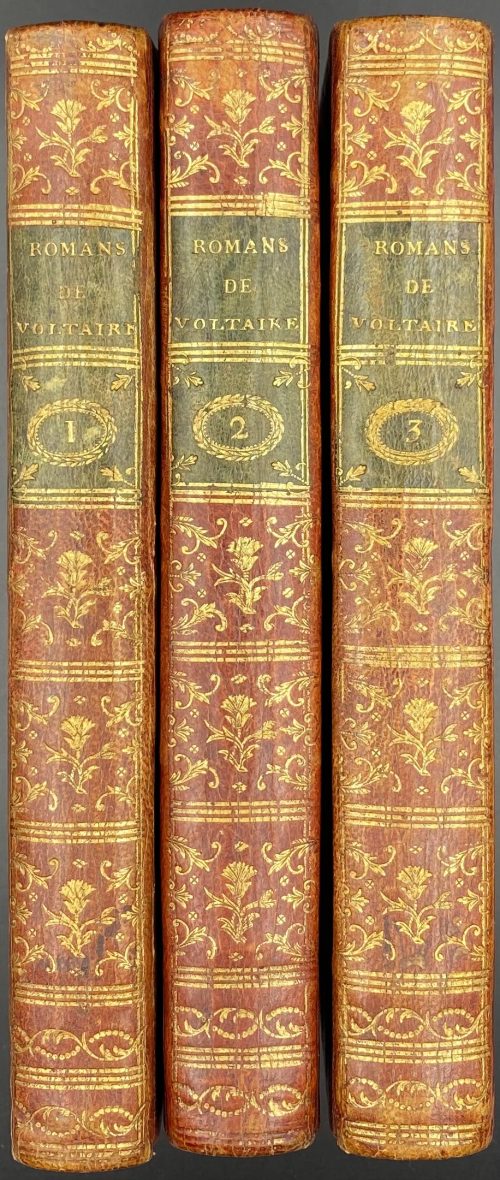 Three volumes, 8vo, 20.5 x 13.5 cm each, uniformly bound in crimson morocco, ruled in triple-fillet gilt, flat spine, triple-fillet gilt-ruled compartments with gilt elements in compartments, two black labels lettered in gilt, marbled endpapers, all edges gilt, multiple woodcut tailpieces. Armorial bookplate of Henricus Liber Baro de Gudenus to front pastedowns in all volumes: “HENRICVS LIBER BARO | DE GVDENVS | 1891 | Jauner”. Title-page: ROMANS | ET | CONTES | DE | M. DE VOLTAIRE | {chain rule} | TOME PREMIER (SECOND; TROISIEME). | {chain rule} | {publisher’s device with motto: “nuper sub modio nunc super”} | A BOUILLON, | AUX DEPENS DE LA SOCIETE TYPOGRAPHIQUE. | {floral rule} | M. DCC. LXXVIII. || Vol. 1: Collation: π2 (h.t., t.p.) a1 (table), A-T8, (Aiv unsigned), total 155 leaves plus 16 leaves of plates, incl. frontispiece, and two blanks – first and last, extraneous to collation. Frontispiece by Cathelin after de La Tour, unsigned t.p. vignette (device), 5 unsigned headpieces, and 15 plates after Monnet by Chatelin, Dambrun (5) Deny (6), Thiébault (2), and Vidal. Pagination: [i-v] vi [1-3] 4-304, total 310 pages, ils. Vol. 2: Collation: π2 (h.t., t.p.) a2 (table), A-V8, total 164 leaves plus 20 leaves of plates, incl. frontispiece, extraneous to collation, no blanks. Frontispiece by Dambrun after Monnet, unsigned t.p. vignette (device), 3 headpieces by Deny after Monnet, 2 unsigned headpieces, 19 plates: after Martiny by Deny; after Monnet by Baquoy, Dambrun (3), Deny (9), and Vidal (4); and after Moreau by Deny. Pagination: [i-v] vi-viii [1-3] 4-320, total 328 pages, ils. Vol.3: π2 (h.t., t.p.) a1 (table), A-O8 P6 a-f8 g1 h2 ('avis au relieur'), total 172 leaves plus 21 leaves of plates, incl. frontispiece, extraneous to collation, no blanks. Frontispiece by Dambrun after Monnet, unsigned t.p. vignette (device), indistinctly signed headpiece to “Jenni” after Monnet (probably Thiébault), 2 unsigned headpieces, 20 plates: after Marillier by Deny (4), Lorieux (2), Patas, and Vidal. Pagination: [i-v] vi [1-3] 4-236, [1-2] 3-102, total 328 pages, ils. Provenance: Heinrich von Gudenus [Heinrich Johann Baptist Ghislain von Gudenus] (Austrian, 1839 – 1915); ref.: Bibliotheca Ecclesiae Metropolitanae Strigoniensis. Catalogue raisonné: Ray (French): № 35, pp. 71-2; Cohen - de Ricci: 1038-9; Lewine: 562-3. Contributors: François Marie Arouet de Voltaire (French, 1694 – 1778) – author. Artists: Clément Pierre Marillier (French, 1740 – 1808) Maurice Quentin de La Tour (French, 1704 – 1788) Charles Monnet [Monet] (French, 1732 – 1819) Pietro Antonio Martini (Italian, 1738 – 1797) Jean-Michel Moreau [Moreau le Jeune] (French, 1741 – 1814) Engravers: Jean Charles Baquoy (French, 1721–1777) Louis-Jacques Cathelin (French, 1738 – 1804) John Baptist Chatelain (British, 1710 – 1758) Jean Dambrun (French, 1741 – 1808/14) Jeanne Deny (French, 1749 – c. 1815) Martial Deny (French, b. 1745) F. B. Lorieux (French, fl. 1786 – 1810) Charles Emmanuel Patas (French, 1744 – 1802) Elisabeth Thiébault (French, 18th century) Gérard Vidal (French, 1742 – 1801)
Three volumes, 8vo, 20.5 x 13.5 cm each, uniformly bound in crimson morocco, ruled in triple-fillet gilt, flat spine, triple-fillet gilt-ruled compartments with gilt elements in compartments, two black labels lettered in gilt, marbled endpapers, all edges gilt, multiple woodcut tailpieces. Armorial bookplate of Henricus Liber Baro de Gudenus to front pastedowns in all volumes: “HENRICVS LIBER BARO | DE GVDENVS | 1891 | Jauner”. Title-page: ROMANS | ET | CONTES | DE | M. DE VOLTAIRE | {chain rule} | TOME PREMIER (SECOND; TROISIEME). | {chain rule} | {publisher’s device with motto: “nuper sub modio nunc super”} | A BOUILLON, | AUX DEPENS DE LA SOCIETE TYPOGRAPHIQUE. | {floral rule} | M. DCC. LXXVIII. || Vol. 1: Collation: π2 (h.t., t.p.) a1 (table), A-T8, (Aiv unsigned), total 155 leaves plus 16 leaves of plates, incl. frontispiece, and two blanks – first and last, extraneous to collation. Frontispiece by Cathelin after de La Tour, unsigned t.p. vignette (device), 5 unsigned headpieces, and 15 plates after Monnet by Chatelin, Dambrun (5) Deny (6), Thiébault (2), and Vidal. Pagination: [i-v] vi [1-3] 4-304, total 310 pages, ils. Vol. 2: Collation: π2 (h.t., t.p.) a2 (table), A-V8, total 164 leaves plus 20 leaves of plates, incl. frontispiece, extraneous to collation, no blanks. Frontispiece by Dambrun after Monnet, unsigned t.p. vignette (device), 3 headpieces by Deny after Monnet, 2 unsigned headpieces, 19 plates: after Martiny by Deny; after Monnet by Baquoy, Dambrun (3), Deny (9), and Vidal (4); and after Moreau by Deny. Pagination: [i-v] vi-viii [1-3] 4-320, total 328 pages, ils. Vol.3: π2 (h.t., t.p.) a1 (table), A-O8 P6 a-f8 g1 h2 ('avis au relieur'), total 172 leaves plus 21 leaves of plates, incl. frontispiece, extraneous to collation, no blanks. Frontispiece by Dambrun after Monnet, unsigned t.p. vignette (device), indistinctly signed headpiece to “Jenni” after Monnet (probably Thiébault), 2 unsigned headpieces, 20 plates: after Marillier by Deny (4), Lorieux (2), Patas, and Vidal. Pagination: [i-v] vi [1-3] 4-236, [1-2] 3-102, total 328 pages, ils. Provenance: Heinrich von Gudenus [Heinrich Johann Baptist Ghislain von Gudenus] (Austrian, 1839 – 1915); ref.: Bibliotheca Ecclesiae Metropolitanae Strigoniensis. Catalogue raisonné: Ray (French): № 35, pp. 71-2; Cohen - de Ricci: 1038-9; Lewine: 562-3. Contributors: François Marie Arouet de Voltaire (French, 1694 – 1778) – author. Artists: Clément Pierre Marillier (French, 1740 – 1808) Maurice Quentin de La Tour (French, 1704 – 1788) Charles Monnet [Monet] (French, 1732 – 1819) Pietro Antonio Martini (Italian, 1738 – 1797) Jean-Michel Moreau [Moreau le Jeune] (French, 1741 – 1814) Engravers: Jean Charles Baquoy (French, 1721–1777) Louis-Jacques Cathelin (French, 1738 – 1804) John Baptist Chatelain (British, 1710 – 1758) Jean Dambrun (French, 1741 – 1808/14) Jeanne Deny (French, 1749 – c. 1815) Martial Deny (French, b. 1745) F. B. Lorieux (French, fl. 1786 – 1810) Charles Emmanuel Patas (French, 1744 – 1802) Elisabeth Thiébault (French, 18th century) Gérard Vidal (French, 1742 – 1801) -
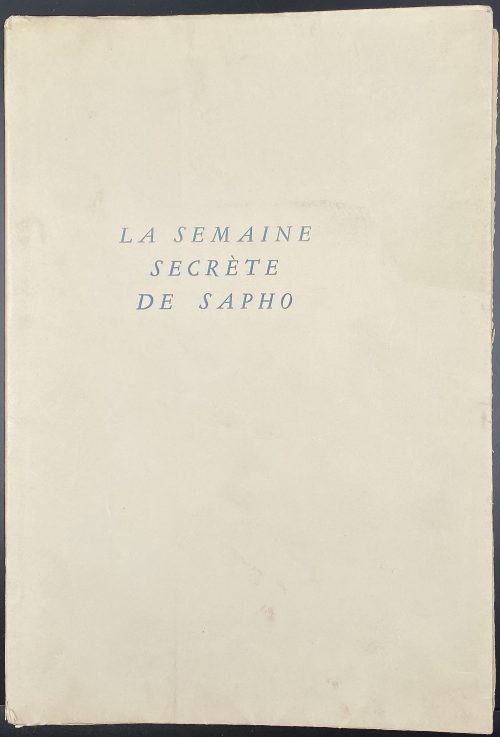 Description: One volume in cream French flapped wrappers, 28.5 x 19.5 cm, lettered to front in blue, printed on wove paper, [1-8] 9-157 [158] [6 blanks] + 8 plates tipped-in; total 82 leaves, first two and last three blank (total 8 blanks), the first and last leaves in the wrappers. Clandestine pirate edition with 8 collotype reproductions of coloured etchings after André Collot. Some plates with a water stain in the upper left corner, one plate has a long closed tear along the left margin. Compare to the original etchings, these plates look dull. Front wrapper (blue): LA SEMAINE | SECRÈTE | DE SAPHO || Title-page (black): LA SEMAINE | SECRÈTE | DE SAPHO | Illustrée de huit gravures | coloriées à la main | LA CHRONIQUE DES DAMES | CONTEMPORAINES || Limitation: The run of 300 copies printed on vélin de luxe “illustrée de huit gravures avec remarques colorées à la main”. This copy is № 128. Note: According to J.-P. Dutel (1920-1970) № 2385, p. 360, it is a pirate edition, printed in c. 1930. Jean-Pierre does not indicate that the plates are collotype reproductions, however, it is obvious when assessed under a microscope with a magnification of 60. The original edition published in 1929 has a different title-page and is illustrated with hand-coloured etchings, see Dutel (1920-1970) № 2384, p. 360. Contributors: Pascal Pia [Pierre Durand] (French, 1903 – 1979) – author. André Collot (French, 1897 – 1976) – artist.
Description: One volume in cream French flapped wrappers, 28.5 x 19.5 cm, lettered to front in blue, printed on wove paper, [1-8] 9-157 [158] [6 blanks] + 8 plates tipped-in; total 82 leaves, first two and last three blank (total 8 blanks), the first and last leaves in the wrappers. Clandestine pirate edition with 8 collotype reproductions of coloured etchings after André Collot. Some plates with a water stain in the upper left corner, one plate has a long closed tear along the left margin. Compare to the original etchings, these plates look dull. Front wrapper (blue): LA SEMAINE | SECRÈTE | DE SAPHO || Title-page (black): LA SEMAINE | SECRÈTE | DE SAPHO | Illustrée de huit gravures | coloriées à la main | LA CHRONIQUE DES DAMES | CONTEMPORAINES || Limitation: The run of 300 copies printed on vélin de luxe “illustrée de huit gravures avec remarques colorées à la main”. This copy is № 128. Note: According to J.-P. Dutel (1920-1970) № 2385, p. 360, it is a pirate edition, printed in c. 1930. Jean-Pierre does not indicate that the plates are collotype reproductions, however, it is obvious when assessed under a microscope with a magnification of 60. The original edition published in 1929 has a different title-page and is illustrated with hand-coloured etchings, see Dutel (1920-1970) № 2384, p. 360. Contributors: Pascal Pia [Pierre Durand] (French, 1903 – 1979) – author. André Collot (French, 1897 – 1976) – artist. -
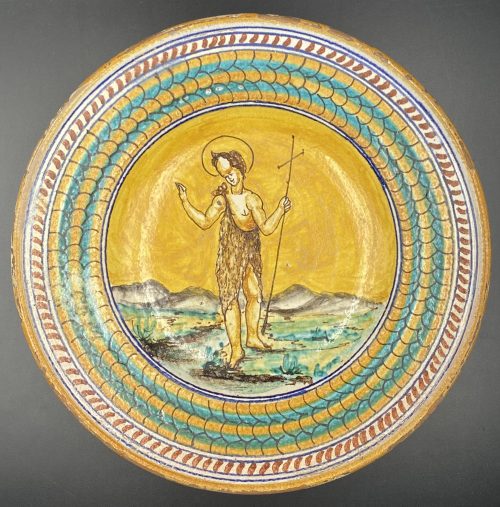 Tin-glazed earthenware polychrome plate of round form, decorated with a figure of John the Baptist wearing clothes of camel's hair with a tall cross in his left hand and with a halo over his head, walking in a desert with hills on the background. The lip is decorated with circles and scales, base with concentric circles. Diameter: 23 cm; Height: 4 cm.
Tin-glazed earthenware polychrome plate of round form, decorated with a figure of John the Baptist wearing clothes of camel's hair with a tall cross in his left hand and with a halo over his head, walking in a desert with hills on the background. The lip is decorated with circles and scales, base with concentric circles. Diameter: 23 cm; Height: 4 cm. -
 Superb Edo pictures illustrating dances (Odori keiyô Edo-e no sakae): Interior of an imaginary theater with a performance of Shibaraku 「踊形容江戸絵栄」. Artist: Utagawa Kunisada [歌川 国貞] a.k.a. Utagawa Toyokuni III [三代歌川豊国] (Japanese, 1786 – 1865). Publisher: Nōshūya Yasubei (Japanese, fl. c. 1851 – 1870). Year: 1858 (Ansei 5), 7th month. Size: Vertical ôban triptych; 36.9 x 75.7 cm. Signed: 一陽斎雛獅豊国筆(年玉印) – Ichiyôsai Hinashi Toyokuni ga (on left sheet only). Censor's seal: Horse 7 [午七 彫師]. Subject: Shibaraku. Ref.: MFA impression: 11.44263a-c; Robert Schaap. Kunisada (2016), p. 101 [LIB-1212.2017]. Ref.: [LIB-1197.2016] Arendie and Henk Herwig. Heroes of the kabuki stage: an introduction to kabuki with retellings of famous plays, illustrated by woodblock prints. — Amsterdam: Hotei Publishing, 2004; p. 38.
Superb Edo pictures illustrating dances (Odori keiyô Edo-e no sakae): Interior of an imaginary theater with a performance of Shibaraku 「踊形容江戸絵栄」. Artist: Utagawa Kunisada [歌川 国貞] a.k.a. Utagawa Toyokuni III [三代歌川豊国] (Japanese, 1786 – 1865). Publisher: Nōshūya Yasubei (Japanese, fl. c. 1851 – 1870). Year: 1858 (Ansei 5), 7th month. Size: Vertical ôban triptych; 36.9 x 75.7 cm. Signed: 一陽斎雛獅豊国筆(年玉印) – Ichiyôsai Hinashi Toyokuni ga (on left sheet only). Censor's seal: Horse 7 [午七 彫師]. Subject: Shibaraku. Ref.: MFA impression: 11.44263a-c; Robert Schaap. Kunisada (2016), p. 101 [LIB-1212.2017]. Ref.: [LIB-1197.2016] Arendie and Henk Herwig. Heroes of the kabuki stage: an introduction to kabuki with retellings of famous plays, illustrated by woodblock prints. — Amsterdam: Hotei Publishing, 2004; p. 38.
-
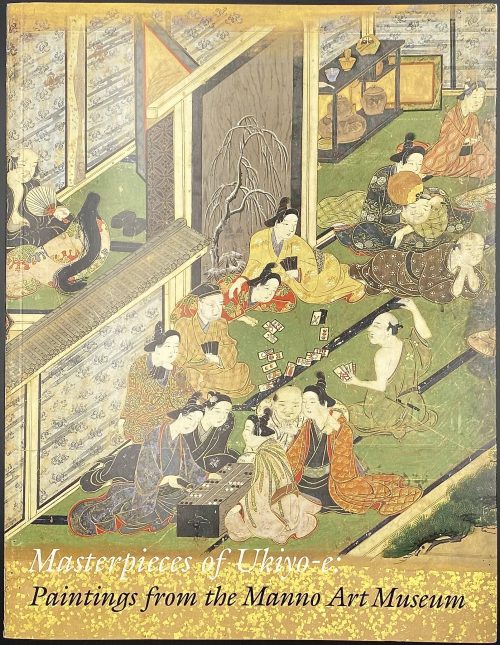 Softcover, in pictorial flapped wrappers, 28 x 21.8 cm, 26 entries, with colour illustrations, some folding. Catalogue # 7 of the sales exhibition on March 25 - April 1, 2003 in NY; pagination: [1-3] 4-90 [2], ils., some folding. Contributor: Sebastian Izzard
Softcover, in pictorial flapped wrappers, 28 x 21.8 cm, 26 entries, with colour illustrations, some folding. Catalogue # 7 of the sales exhibition on March 25 - April 1, 2003 in NY; pagination: [1-3] 4-90 [2], ils., some folding. Contributor: Sebastian Izzard -
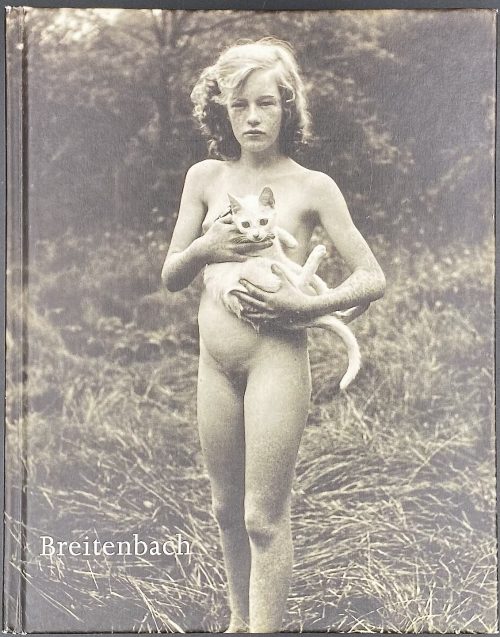 A pictorial photographic album, 19.5 x 15.3 cm, hardcover, paper pictorial covers, pictorial endpapers, pp. [2] 3-39 [40]; total 20 leaves; text by Susan Jacobasch, photographs by Josef Breitenbach. Published in connection with the exhibition "Josef Breitenbach" on October, 10 – November 28, 1998, at Galerie Bodo Niemann in Berlin. Josef Breitenbach (Jewish-German-American, 1896 – 1984).
A pictorial photographic album, 19.5 x 15.3 cm, hardcover, paper pictorial covers, pictorial endpapers, pp. [2] 3-39 [40]; total 20 leaves; text by Susan Jacobasch, photographs by Josef Breitenbach. Published in connection with the exhibition "Josef Breitenbach" on October, 10 – November 28, 1998, at Galerie Bodo Niemann in Berlin. Josef Breitenbach (Jewish-German-American, 1896 – 1984). -
 Artist: Utagawa Kuniyoshi [歌川 國芳] (Japanese, 1798 – 1861). Publisher: Ibaya Senzaburō [伊場屋仙三郎] (Japanese, c. 1815 – 1869). Published in c. 1845 (no seal). Possibly, from the "Untitled series of beauties reflected in mirrors", see Kunisada Project. However, this print does not have the seal of the censor Tanaka [田中].
Artist: Utagawa Kuniyoshi [歌川 國芳] (Japanese, 1798 – 1861). Publisher: Ibaya Senzaburō [伊場屋仙三郎] (Japanese, c. 1815 – 1869). Published in c. 1845 (no seal). Possibly, from the "Untitled series of beauties reflected in mirrors", see Kunisada Project. However, this print does not have the seal of the censor Tanaka [田中]. -
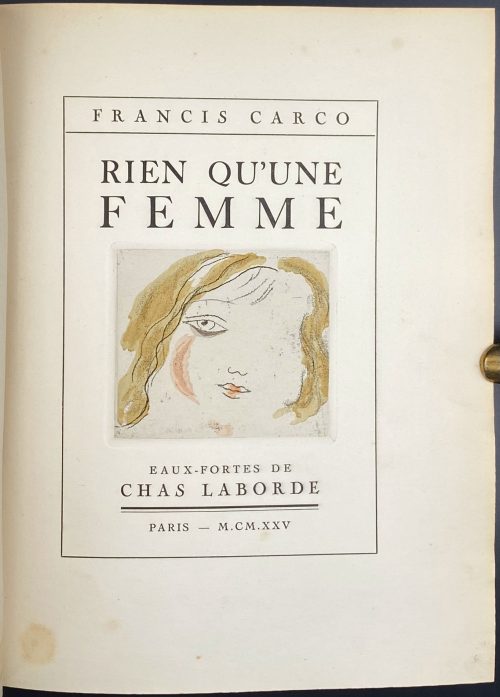 Title-page (text in frame): FRANCIS CARCO | RIEN QU'UNE | FEMME | {vignette} | EAUX-FORTES DE | CHAS LABORDE | — | PARIS — M.CM.XXV || Description: 4to, 24.5 x 20 cm, owner’s red cloth, yellow leather label with gilt lettering to spine, original wrappers bound in, woodcut bookplate “ИЗ КНИГ Ф.РОЖАНКОВСКАГО” to front pastedown; chapter titles and initials printed in pink. Collation: fep, 2 blanks before front wrapper, front wrapper with a black lettered pink label, 2 blanks, h.t., t.p., dedication, 1-204 212,2 blanks, rear wrapper, 2 blanks, rep; total 89 leaves within wrappers, plus 15 plates with tissue guards, incl. frontispiece – hand-coloured etchings by Chas [Charles] Laborde, extraneous to collation. In some copies, there are two additional plates. Pagination: [10] [1] 2-162 [2 colophon/blank] [4], total 178 pages. Limitation: Date of printing: September 15, 1925. Printer: Imprimeur Coulouma (Argenteuil) Print run: 267 copies of which 1 copy on Japon Ancien (№1), 15 on Japon Impérial (№№ 2-16), 60 on Hollande (№№ 17-76), and 200 copies on Vélin de Rives (№№ 77-276) ; this is copy № 82. Etchings printed on BFK Rives paper (embossed). Provenance: Rojankovsky, Feodor [Rojan; Рожанковский, Фёдор Степанович] (Russian-American, 1891 – 1970). Contributors: Francis Carco [François Carcopino-Tusoli] (French, 1886 – 1958) – author. Chas Laborde [Charles Laborde] (French, 1886 – 1941) – artist. Roger Lacourière (French, 1892 – 1966) – engraver.
Title-page (text in frame): FRANCIS CARCO | RIEN QU'UNE | FEMME | {vignette} | EAUX-FORTES DE | CHAS LABORDE | — | PARIS — M.CM.XXV || Description: 4to, 24.5 x 20 cm, owner’s red cloth, yellow leather label with gilt lettering to spine, original wrappers bound in, woodcut bookplate “ИЗ КНИГ Ф.РОЖАНКОВСКАГО” to front pastedown; chapter titles and initials printed in pink. Collation: fep, 2 blanks before front wrapper, front wrapper with a black lettered pink label, 2 blanks, h.t., t.p., dedication, 1-204 212,2 blanks, rear wrapper, 2 blanks, rep; total 89 leaves within wrappers, plus 15 plates with tissue guards, incl. frontispiece – hand-coloured etchings by Chas [Charles] Laborde, extraneous to collation. In some copies, there are two additional plates. Pagination: [10] [1] 2-162 [2 colophon/blank] [4], total 178 pages. Limitation: Date of printing: September 15, 1925. Printer: Imprimeur Coulouma (Argenteuil) Print run: 267 copies of which 1 copy on Japon Ancien (№1), 15 on Japon Impérial (№№ 2-16), 60 on Hollande (№№ 17-76), and 200 copies on Vélin de Rives (№№ 77-276) ; this is copy № 82. Etchings printed on BFK Rives paper (embossed). Provenance: Rojankovsky, Feodor [Rojan; Рожанковский, Фёдор Степанович] (Russian-American, 1891 – 1970). Contributors: Francis Carco [François Carcopino-Tusoli] (French, 1886 – 1958) – author. Chas Laborde [Charles Laborde] (French, 1886 – 1941) – artist. Roger Lacourière (French, 1892 – 1966) – engraver. -
 Iron tsuba of a spindle shape (tate-itomaki-gata) pierced and inlaid in brass suemon-zōgan with bellflowers, vines and foliage, and a dragonfly in the upper right corner, on both sides. One of the hitsu-ana plugged with grey metal (led or pewter), nakaga-ana fitted with copper sekigane. The shape of the tsuba may be interpreted as four saddles connected to each other by horse bits. Such a design of sukashi and zōgan is usually attributed to Kaga Yoshirō branch of Heianjo school, active in the second half of the 17th century (c. 1650-1700). Size: 95.9 mm diagonal; 4.1 mm thickness. Tokubetsu Kicho certificate № 332 issued by NBTHK on October 12, 1965.
Iron tsuba of a spindle shape (tate-itomaki-gata) pierced and inlaid in brass suemon-zōgan with bellflowers, vines and foliage, and a dragonfly in the upper right corner, on both sides. One of the hitsu-ana plugged with grey metal (led or pewter), nakaga-ana fitted with copper sekigane. The shape of the tsuba may be interpreted as four saddles connected to each other by horse bits. Such a design of sukashi and zōgan is usually attributed to Kaga Yoshirō branch of Heianjo school, active in the second half of the 17th century (c. 1650-1700). Size: 95.9 mm diagonal; 4.1 mm thickness. Tokubetsu Kicho certificate № 332 issued by NBTHK on October 12, 1965. -
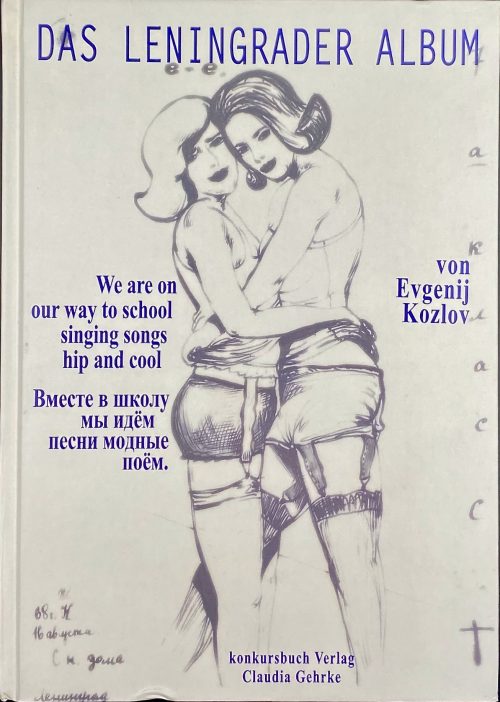 Hardcover volume, 24.5 x 17.5 cm, pictorial boards and endpapers, pp. [2] 3-167 [168]; 2 t.p., 129 pp. of plates, 33 pp. of text, 4 pp. of thumbnails, 1 colophon. Front cover (grey vignette, blue lettering): Das Leningrader Album | We are on | our way to school | singing songs | hip and cool | Вместе в школу | мы идём | песни модные | поём. | von | Evgenij | Kozlov | konkursbuch Verlag | Claudia Gehrke || ISBN: 3-88769-315-9. Evgenij Kozlov (Russian-German, b. 1955) – artist.
Hardcover volume, 24.5 x 17.5 cm, pictorial boards and endpapers, pp. [2] 3-167 [168]; 2 t.p., 129 pp. of plates, 33 pp. of text, 4 pp. of thumbnails, 1 colophon. Front cover (grey vignette, blue lettering): Das Leningrader Album | We are on | our way to school | singing songs | hip and cool | Вместе в школу | мы идём | песни модные | поём. | von | Evgenij | Kozlov | konkursbuch Verlag | Claudia Gehrke || ISBN: 3-88769-315-9. Evgenij Kozlov (Russian-German, b. 1955) – artist. -
 The so-called Yoshirō-tsuba [与四郎鐔] with an iron plate of mokkō form densely decorated with floral arabesque and adorned with eight pierced, chiselled and inlaid brass roundels and signed on both sides 'Koike Yoshirō Izumi no Kami Naomasa'. Four of the roundels are pierced and have geometrical designs representing flowers (e.g. wood sorrel) or snowflakes. Four others are solid and represent family crests; on one side: Mulberry (kaji) – mon of the Matsunaga clan [松永氏], Bamboo Grass (sasa) – mon of the Takenaka clan [竹中氏]), Wild Geese (kari) – mon of the Shibata clan [新発田氏]), and Pine Needles (matsuba); on the other side: Nine Stars (kuyō) – the Hosokawa clan [細川氏], Paulownia (kiri) – the Toyotomi clan [豊臣氏]), Bamboo Leaves (take) – the Minamoto clan [源], and Seven Treasures (shippo) – Izumo Genji clan [出雲源氏]. Hitsu-ana obliterated with a nanako-treated pewter plug. Brass with rainbow patina. Artist: Koike Izumi no Kami Naomasa (Japanese, active late 16th – early 17th century). The Momoyama or early Edo period, end of the 16th to the first half of the 17th century (1574-1650). Size: 81.7 x 78.8 x 4.3 cm. Provenance: Dr. Kazutaro Torigoye. Special thanks to Markus Sesko for providing the translation of hakogaki. Hakokaki lid (outside): 小池与四郎 – Koike Yoshirō Hakokaki lid (inside): 銘曰小池与四郎 – Mei’etsu: Koike Yoshirō – Signed: Koike Yoshirō 和泉守直正 – Izumi no Kami Naomasa – Izumi no Kami Naomasa 木瓜形 鉄地 – Mokkōgata, tetsu-ji – Lobed shape, of iron 真鍮据紋象嵌 – Shinchū suemon-zōgan – with brass suemon-zōgan inlay 縦二寸七分横二寸六分 – Tate ni-sun shichi-bu, yoko ni-sun roku-bu – Height 8.2 cm, width 7.9 cm 右正真也 – Migi shōshin nari – Above described object is authentic 昭和廾九年八月十一日 – Shōwa nijūkyūnen hachigatsu jūichinichi – August 11, 1954 草堂「花押」– Sōdō + kaō – Sōdō [pen name of Torigoye Kazutarō, 鳥越一太郎] + monogram Ref.: (1) Tsuba Geijutsu-Ko by Kazutaro Torigoye, 1960; (2) Tsuba. An aesthetic study. By Kazutaro Torigoye and Robert E. Haynes from the Tsuba Geijutsu-kō of Kazataro Torigoye. Edited and published by Alan L. Harvie for the Nothern California Japanese Sword Club, 1994-1997, p. Yoshirō, 4. See also Yoshirō tsuba.
The so-called Yoshirō-tsuba [与四郎鐔] with an iron plate of mokkō form densely decorated with floral arabesque and adorned with eight pierced, chiselled and inlaid brass roundels and signed on both sides 'Koike Yoshirō Izumi no Kami Naomasa'. Four of the roundels are pierced and have geometrical designs representing flowers (e.g. wood sorrel) or snowflakes. Four others are solid and represent family crests; on one side: Mulberry (kaji) – mon of the Matsunaga clan [松永氏], Bamboo Grass (sasa) – mon of the Takenaka clan [竹中氏]), Wild Geese (kari) – mon of the Shibata clan [新発田氏]), and Pine Needles (matsuba); on the other side: Nine Stars (kuyō) – the Hosokawa clan [細川氏], Paulownia (kiri) – the Toyotomi clan [豊臣氏]), Bamboo Leaves (take) – the Minamoto clan [源], and Seven Treasures (shippo) – Izumo Genji clan [出雲源氏]. Hitsu-ana obliterated with a nanako-treated pewter plug. Brass with rainbow patina. Artist: Koike Izumi no Kami Naomasa (Japanese, active late 16th – early 17th century). The Momoyama or early Edo period, end of the 16th to the first half of the 17th century (1574-1650). Size: 81.7 x 78.8 x 4.3 cm. Provenance: Dr. Kazutaro Torigoye. Special thanks to Markus Sesko for providing the translation of hakogaki. Hakokaki lid (outside): 小池与四郎 – Koike Yoshirō Hakokaki lid (inside): 銘曰小池与四郎 – Mei’etsu: Koike Yoshirō – Signed: Koike Yoshirō 和泉守直正 – Izumi no Kami Naomasa – Izumi no Kami Naomasa 木瓜形 鉄地 – Mokkōgata, tetsu-ji – Lobed shape, of iron 真鍮据紋象嵌 – Shinchū suemon-zōgan – with brass suemon-zōgan inlay 縦二寸七分横二寸六分 – Tate ni-sun shichi-bu, yoko ni-sun roku-bu – Height 8.2 cm, width 7.9 cm 右正真也 – Migi shōshin nari – Above described object is authentic 昭和廾九年八月十一日 – Shōwa nijūkyūnen hachigatsu jūichinichi – August 11, 1954 草堂「花押」– Sōdō + kaō – Sōdō [pen name of Torigoye Kazutarō, 鳥越一太郎] + monogram Ref.: (1) Tsuba Geijutsu-Ko by Kazutaro Torigoye, 1960; (2) Tsuba. An aesthetic study. By Kazutaro Torigoye and Robert E. Haynes from the Tsuba Geijutsu-kō of Kazataro Torigoye. Edited and published by Alan L. Harvie for the Nothern California Japanese Sword Club, 1994-1997, p. Yoshirō, 4. See also Yoshirō tsuba. -
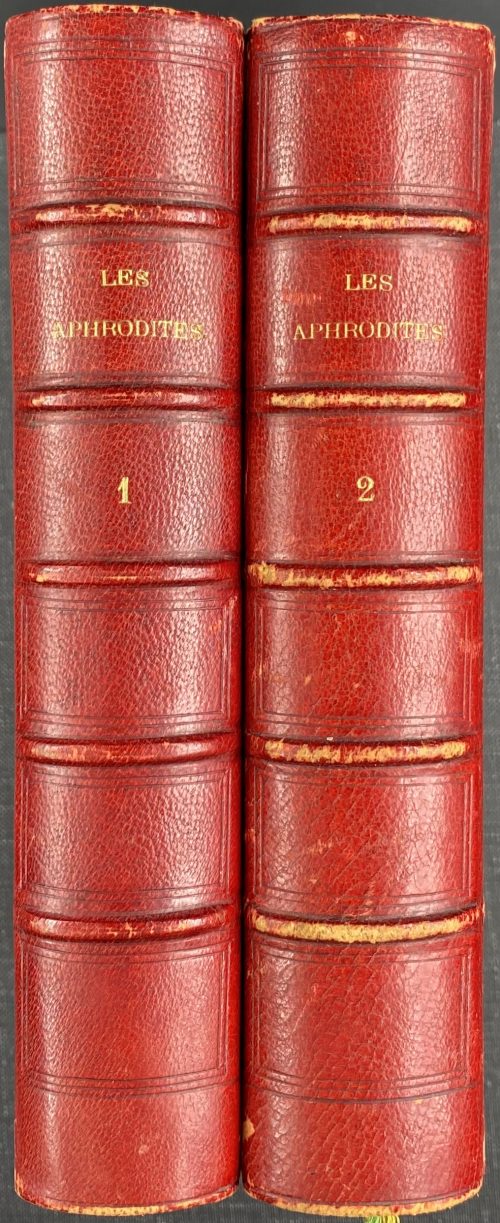 Two volumes in-12, 16.7 x 11.5 x 3.5 cm each, uniformly bound in quarter crimson morocco over marbled boards, spine with raised bands, gilt lettering, marbled endpapers, top margin gilt; text printed on laid paper, plates – on India paper: loose frontispiece by Félix Lukkow after Félicien Rops with tissue guard and 4 loose engraved plates by Félix Lukkow after Sigmund Freudenberger, in each volume. This edition is a reprint of an earlier publication: ANDRÉA DE NERCIAT, André-Robert (1739 - 1800). Les Aphrodites ou Fragments thali-priapiques pour servir à l'histoire du plaisir. Numéro Un et deux [Numéro trois et quatre [...] sept et huit]. 1793-1864. [Bruxelles : Briard pour Poulet-Malassis, 1864] with plated recarved by Félix Lukkow. Title-page: LES | APHRODITES | OU | FRAGMENTS THALI-PRIAPIQUES | POUR SERVIR A | L’HISTOIRE DU PLAISIR | — | Priape, soutiens mon hàleine… | Piron, Ode | — | Tome premier (second). | {publisher’s device} | A LAMPSAQUE | – | 1793 || Limitation: Edition is limited to 150 copies of which 130 on papier vergé, 5 on papier album jaune, 10 copies in-8o on large papier fort de Hollande, and one unique copy on peau de vélin. The number of this copy is left blank in both volumes. Vol. 1: π4 (h.t./limit., t.p./table, Éclaircissements historiques par V. M. D.), 1-2712 2910; total 182 leaves plus 5 leaves of plates, incl. frontispiece. Pagination: [1-5] 6-364, ils. V. M. D. stands for Vital Désiré Maximilien [Puissant]. Vol. 2: π2 (h.t., t.p.), 1-2912, 3110; total 192 leaves plus 5 leaves of plates, incl. frontispiece. Pagination: [1-5] 6-384, ils. Catalogue raisonné: Dutel I: A-95. Catalogue Poulet-Malassis & ses amis description: № 67. André-Robert ANDRÉA DE NERCIAT - [Félix LUKKOW]. Les Aphrodites, ou fragments thali-priapiques pour servir à l’histoire du plaisir. Tome premier (— second). A Lampsaque, 1793 [Vital Puissant, vers 1872]. 2 volumes in-12 de 364 et 384 pages, demi-maroquin rouge, dos à nerfs, tête dorée, non rogné (reliure de l’époque). Illustré de 2 frontispices et 8 planches volantes, par Félix Lukkow, d’après Félicien Rops pour les frontispices et Freundeberg pour les figures. Tirage limité à 151 ex. Contributors: André-Robert Andréa de Nerciat (French, 1739 – 1800) – author. Sigmund Freudenberger (Swiss, 1745 – 1801) – artist. Félicien Rops (Belgian, 1833 – 1898) – artist. Félix Lukkow (French, fl. c. 1870 – 1875) – engraver.
Two volumes in-12, 16.7 x 11.5 x 3.5 cm each, uniformly bound in quarter crimson morocco over marbled boards, spine with raised bands, gilt lettering, marbled endpapers, top margin gilt; text printed on laid paper, plates – on India paper: loose frontispiece by Félix Lukkow after Félicien Rops with tissue guard and 4 loose engraved plates by Félix Lukkow after Sigmund Freudenberger, in each volume. This edition is a reprint of an earlier publication: ANDRÉA DE NERCIAT, André-Robert (1739 - 1800). Les Aphrodites ou Fragments thali-priapiques pour servir à l'histoire du plaisir. Numéro Un et deux [Numéro trois et quatre [...] sept et huit]. 1793-1864. [Bruxelles : Briard pour Poulet-Malassis, 1864] with plated recarved by Félix Lukkow. Title-page: LES | APHRODITES | OU | FRAGMENTS THALI-PRIAPIQUES | POUR SERVIR A | L’HISTOIRE DU PLAISIR | — | Priape, soutiens mon hàleine… | Piron, Ode | — | Tome premier (second). | {publisher’s device} | A LAMPSAQUE | – | 1793 || Limitation: Edition is limited to 150 copies of which 130 on papier vergé, 5 on papier album jaune, 10 copies in-8o on large papier fort de Hollande, and one unique copy on peau de vélin. The number of this copy is left blank in both volumes. Vol. 1: π4 (h.t./limit., t.p./table, Éclaircissements historiques par V. M. D.), 1-2712 2910; total 182 leaves plus 5 leaves of plates, incl. frontispiece. Pagination: [1-5] 6-364, ils. V. M. D. stands for Vital Désiré Maximilien [Puissant]. Vol. 2: π2 (h.t., t.p.), 1-2912, 3110; total 192 leaves plus 5 leaves of plates, incl. frontispiece. Pagination: [1-5] 6-384, ils. Catalogue raisonné: Dutel I: A-95. Catalogue Poulet-Malassis & ses amis description: № 67. André-Robert ANDRÉA DE NERCIAT - [Félix LUKKOW]. Les Aphrodites, ou fragments thali-priapiques pour servir à l’histoire du plaisir. Tome premier (— second). A Lampsaque, 1793 [Vital Puissant, vers 1872]. 2 volumes in-12 de 364 et 384 pages, demi-maroquin rouge, dos à nerfs, tête dorée, non rogné (reliure de l’époque). Illustré de 2 frontispices et 8 planches volantes, par Félix Lukkow, d’après Félicien Rops pour les frontispices et Freundeberg pour les figures. Tirage limité à 151 ex. Contributors: André-Robert Andréa de Nerciat (French, 1739 – 1800) – author. Sigmund Freudenberger (Swiss, 1745 – 1801) – artist. Félicien Rops (Belgian, 1833 – 1898) – artist. Félix Lukkow (French, fl. c. 1870 – 1875) – engraver.


